#I was listening to the verbal component highlights and this happened
Explore tagged Tumblr posts
Text
New fic! What if the final battle in arc 3 went different? What if Annie died?
#unprepared casters#unprepared casters fic#gonna raise hell#annie wintersummer#annie x lathe#unprepared casters spoilers#angst#I was listening to the verbal component highlights and this happened#character death#canonical character death#non canonical character death
11 notes
·
View notes
Note
I really, really hate the scene in "Heart, Part 1" in which Catra abandons Adora. It's pretty much a culmination of all my issues with Catradora as a whole. Adora is at her most vulnerable, she needs someone to have her back, she NEEDS a friend to support her, because she's scared and she's tired and she still has to do so much. What does Catra do? She leaves. And when Adora stops and confronts her about it, she verbally abuses Adora. Why? (Part 1)
(Part 2) Because, once again, Catra couldn't handle the fact that not everything in Adora's life revolved around her. And then she has the nerve to guilt-trip Adora for wanting to save everybody, Catra included. from Horde Prime. When Catra herself KNEW what Horde Prime was capable of. But no. Tearing Adora down and almost destroying her emotionally one more time for her own ego was more important than the literal fate of the universe.
Dear @justmenoworries,
Firstly, I just want to talk about your statement here:
“And then she has the nerve to guilt-trip Adora for wanting to save everybody, Catra included.”
In my opinion, you’ve highlighted a really big problem with the writing. I feel that the writers were trying to convey this idea that Adora should value herself and not always be self-sacrificing. But I feel the idea is not presented well in S5. I feel like Adora is somewhat punished for risking her life to save people in S5 and this should not have happened. Adora’s choice was selfless and heroic. And so I feel there were better ways to demonstrate Adora being less self-sacrificing and to indicate that Adora values herself.
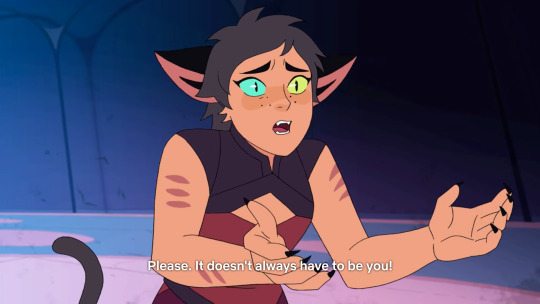
...
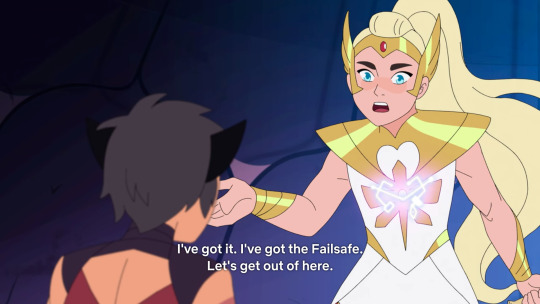
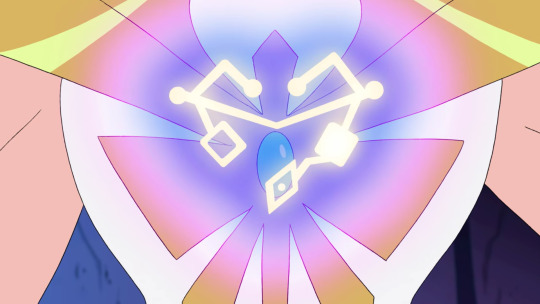
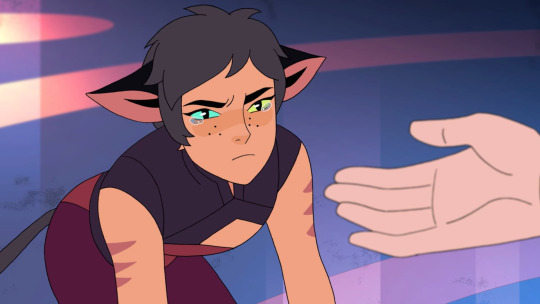
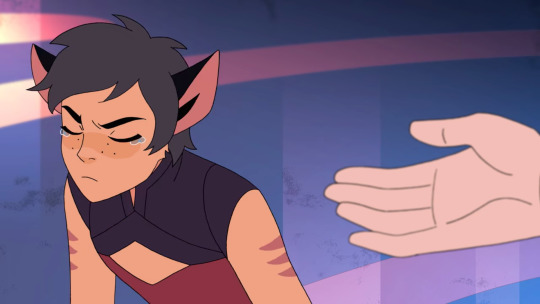

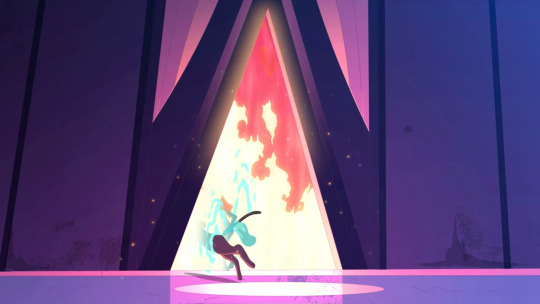
Secondly, it’s really funny that you brought up your frustration with the scene where Catra leaves Adora in “Failsafe” (S5E11) and the scene where Catra confesses her love for Adora in “Heart Part 1” (S5E12) because I have literally been thinking about these two scenes!
There’s a lot going on in these 2 scenes so I’ll do my best to break them down accordingly.
1) Scene 1
Starting with Part 1 of Scene 1:
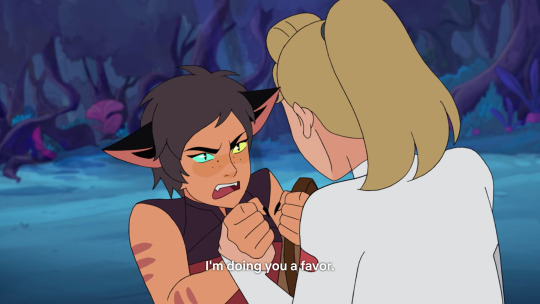


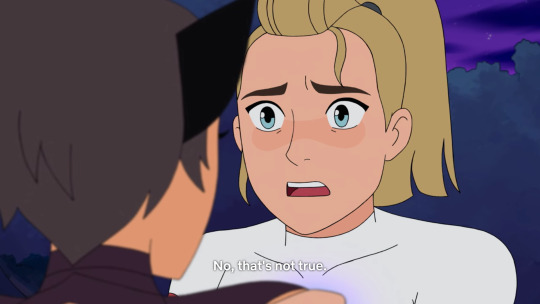
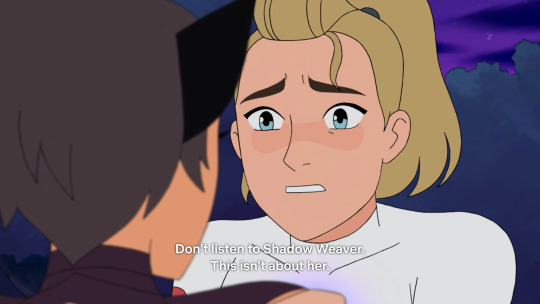

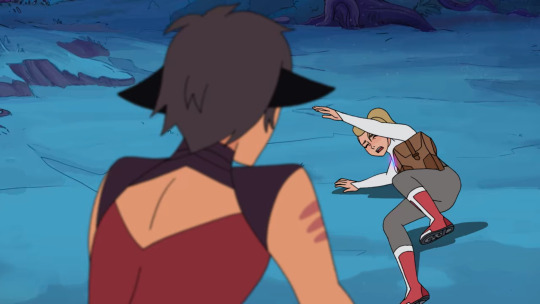
Part 1: Firstly, this part relates to a previous scene where Catra overhears Shadow Weaver comment on Catra being “a distraction”:
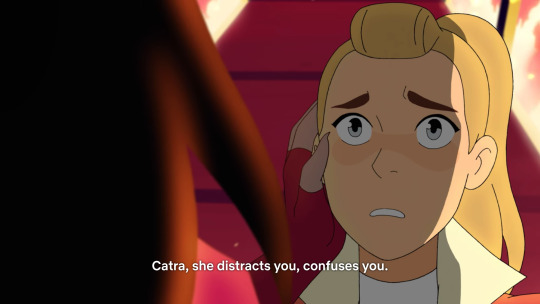
...

Part 1: So this part indicates that Shadow Weaver’s words affected Catra and influenced Catra’s decision to leave Adora.
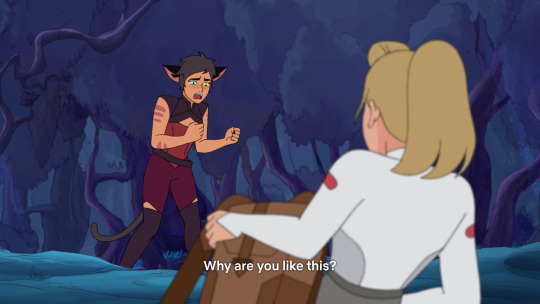

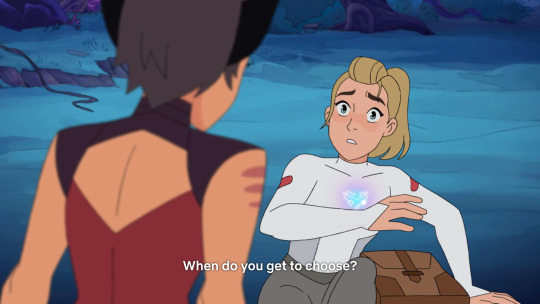



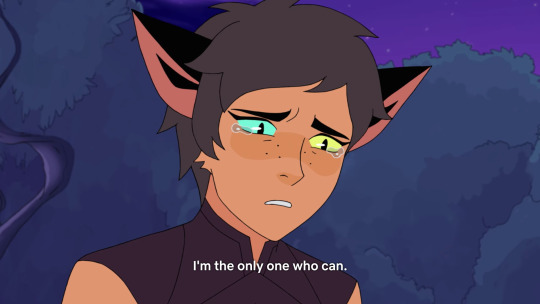
Part 2: This part demonstrates how Catra does want what’s best for Adora. Catra wants Adora to be happy and Catra wants Adora to put herself first.
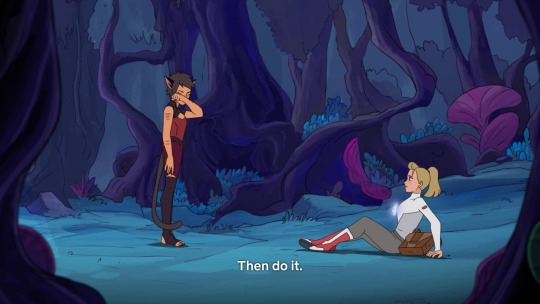


Part 3: However, this part demonstrates that Catra still doesn’t understand that Adora’s choice isn’t because Adora wants to sacrifice her life, rather, Adora is making a choice to save everyone. There is a lot of hypocrisy in this scene, since the very reason Catra is alive is due to the fact that Adora made a choice to risk her own life to save Catra even after Catra tried to murder Adora multiple times during the series.

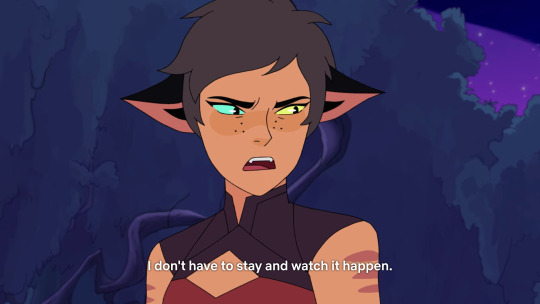
Part 4: Even though the statement “I don’t have to stay and watch it happen” has a meaning of “I don’t want to watch you die”, the words hold a harshness and the final facial expression is anger. Catra is angry with Adora because Adora is taking a risk that might kill her. But I feel like anger is not the right sentiment here. Adora is scared and making a hard decision to put her life on the line in order to save everyone. Adora needs support and Adora needs love.
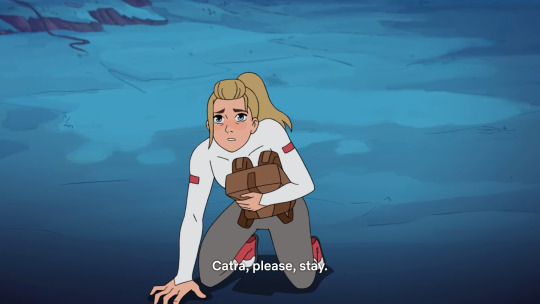


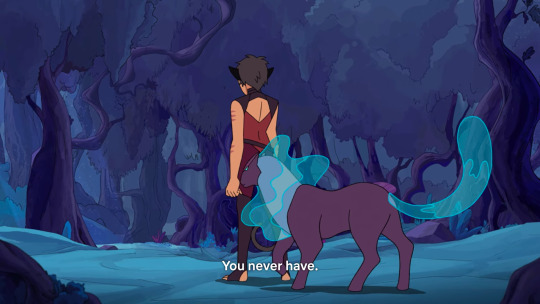
Part 5: I feel like this part highlights 3 key points:
- Catra was leaving more because of her own self-dislike and self-doubt rather than just leaving Adora purely out of spite. In this situation, I feel that Shadow Weaver’s words are still affecting Catra.
- Catra doesn’t listen to Adora or trust Adora. Adora is literally on her knees begging for Catra to stay and stating “I need you”. But Catra doesn’t believe what Adora is saying, even though Adora risked everything in order to rescue Catra from Horde Prime.
- Catra doesn’t stay to support Adora when Adora is scared. Even though, at the very beginning of season 5, Catra was scared and asked Adora to stay. And Adora listened to Catra, sympathized with her, and stayed to support Catra even though Catra tried to kill Adora multiple times throughout the show:

...
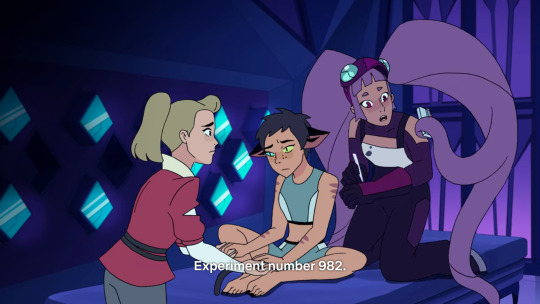
The main takeaway from this part is that Catra has not processed her trauma related to Shadow Weaver enough to the point where Catra can trust and listen to Adora. And I don’t expect Catra to have processed her trauma! Processing trauma is difficult and takes time. But I just want to present the fact that Catra still needs time to process her trauma because it’s clearly interfering with her relationship with Adora.
In addition, trust and communication are the most basic components of any friendship/relationship, so the fact that Catra’s and Adora’s relationship lacks these key components is very problematic.
2) Scene 2
Now, Scene 2 presents Catra at her most vulnerable, which is indicated by her confession of love for Adora. In addition, Catra’s reasoning for leaving Adora completely changes from Scene 1, which will be demonstrated in the next 3 parts:
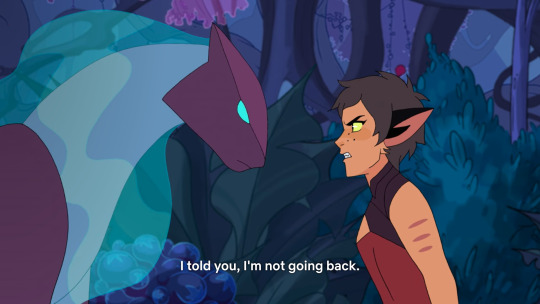
...
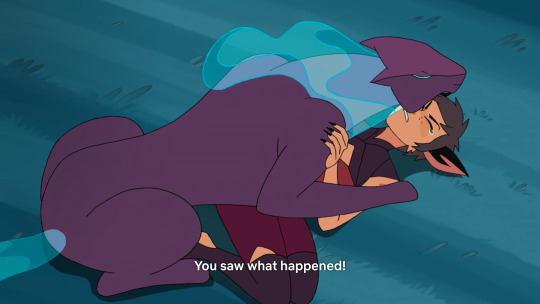
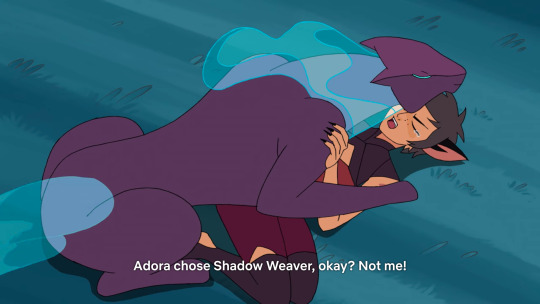
Part 1: This part shows that Catra still thinks that Adora is choosing Shadow Weaver over her. This is false. Adora’s choices are to help save everyone and Adora previously explained that to her:
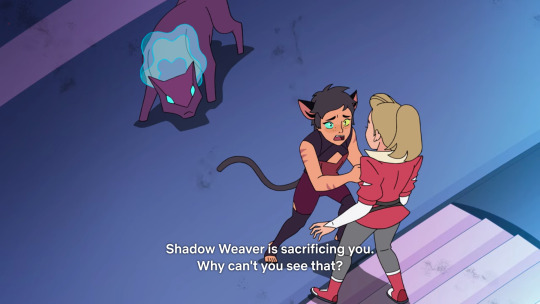
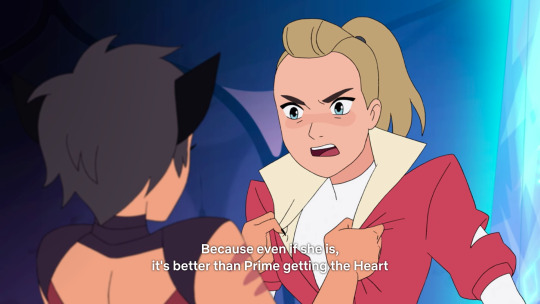
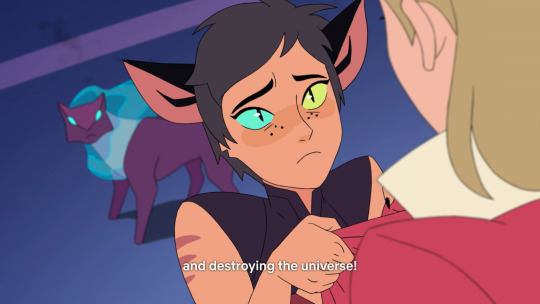

Next,

Part 2: This part demonstrates again that Catra doesn’t trust or listen to Adora. Adora literally said “Please stay” and “I need you” in the previous scene (Scene 1).

Part 3: This part further supports that Catra is focused on her wants and her needs. Adora is literally about to sacrifice her life to save everyone and Catra is concerned that Adora doesn’t reciprocate her feelings.
And so there is a stark disconnect between Scene 1 and Scene 2 about Catra’s reasoning for leaving Adora. In Scene 1, Catra leaves because she feels that she is not helpful to Adora ( Adora: “I need you.”, Catra: “No, you don’t. You never have.”) . However, in Scene 2, Catra justifies her choice for leaving Adora by blaming Adora for choosing Shadow Weaver ( Catra: “I told you, I’m not going back. You saw what happened. Adora chose Shadow Weaver, okay? Not me! ) .
So the fact that when Catra is alone and at her most vulnerable, Catra automatically shifts to blaming Adora is actually terrifying. In addition, Catra still does not understand that Adora’s choice to work with Shadow Weaver is a choice to save everyone. And this happened before when Catra was upset that “Adora left her”, but really Adora had left the Horde in order to protect innocent citizens from dying. Catra still doesn’t see the bigger picture of why Adora is making these choices that lead to the ultimate outcome of saving everyone.
Overall, the 2 scenes demonstrate that Catra doesn’t trust or listen to Adora. And Catra still doesn’t understand Adora’s choice to save everyone.
Thus, the 2 scenes are very indicative of the amount of growth and healing Catra still needs to experience before she can enter any romantic relationship.
Thank you again for sharing your frustrations with these scenes and I hope I explained the scenes well! ✨
#anti catradora#anti c//a#spop critical#spop salt#anti-catradora-receipts#i just wanted to say if you're processing trauma#or if you've ever processed trauma#i'm really proud of you#you're doing such a great job#keep going <3
131 notes
·
View notes
Note
why do you think kyman is so popular? (ew)
okay so this has been sitting in my inbox for about a week or so now and i really just need to answer it and get it over with. really i think this is the most i’m ever going to say at length about kyman so here we go. also i’ve been drinking a little so i apologize in advance if my thoughts aren’t as cohesive as they could be lmao
to answer the initial question, i honestly have no idea. i have a few theories, but no real concrete answer as to why kyman as a ship is so popular; i’m speaking as someone who has had an intimate awareness of this fandom from the time i was ten, which is literally half of my life. i can’t recall kyman being a big ship, or even one of the more common rare-pairs 10 years ago – back then the major ships were style, creek, and k2 (almost pretty much in that order).
kyman, as i know it and have observed it since i’ve re-familiarized myself with the show and its fandom, is more a development that’s largely happened within the past five years and i think the main contributor to this is that, within that same time period, there’s been a noticeable shift with how kyle and cartman’s dynamic has been written; in the beginning seasons, kyle and cartman are shown to equally despise each other. the cartman of seasons 1-4 isn’t exactly the cartman we know now – he started off as kind of a stereotypical fat little neighborhood bully, but he’s always been narcissistic, racist, selfish etc. just not to the same extent he is now. and back then, kyle and cartman interact as enemies would; they argue and fight constantly, openly express their disdain for each other to anyone who will listen, and actively conspire against the other. kyle and cartman were direct foils to each other.
this has changed in the recent past. cartman and kyle aren’t really considered enemies anymore, but instead as rivals which i think is an important thing to note. now, they’re even occasionally on the same side of a conflict or event (such as tfbw). there has been a lot of focus in the past five or six seasons in the ways kyle and cartman are similar; they’re both temperamental and very angry people, incredibly competitive, both very driven and committed when they set their mind to something. kyle, to a lesser degree, also shares one of cartman’s worst traits; they’re both over-reactive and allow themselves to think the world is out to get them. obviously – and i cannot stress this enough – kyle has in no way the victim complex cartman has, but it is there nonetheless. the running theme with season 21 has been self-victimization, and while i don’t entirely agree with their idea that the potential destructive effects of habitual othering and alienation is, like, a concept of personal responsibility or individual desire to be a victim, other than heidi, kyle is a great example of this. for the last three seasons kyle has been the whipping boy in that no one wants his speeches, no one wants his moral lesson; no one wants his opinion. and kyle indirectly and without meaning to spearheads canada being bombed because he allows his emotions to dictate his action. there’s too many instances of cartman doing this exact thing with obvious malicious intent, but “the list” is another notable episode where kyle does the same thing; he feels slighted and estranged when everyone thinks he’s ugly, and instead of listening to reason from either stan or abraham lincoln, he decides the best choice of action is to burn down the school. my point is, kyle and cartman share quite a few personality traits and their interactions in recent seasons tend to highlight and expand on this rather than to treat them as divisive, opposite characters.
they’ve done a lot more as well to show that kyle, unlike his very early characterization in-series where he couldn’t give less of a shit if cartman died, now cares for him on – at the very least– a humanistic level. whereas kenny and stan are still mostly indifferent to cartman and what happens to him, kyle now often objects to directly conspiring to hurt or let cartman put himself in danger, even if he still despises him as a person. this started around season 8 or so with “up the down steroid” and i think this quote from kyle when he goes to cartman’s house best sums up what i’m talking about:
“I know that I often have serious moral objections to the things that you do, but… this time I think you really need to reconsider. Because if you do this, I believe you will go to hell. So I feel it is my responsibility, as your friend, to tell people what you’re doing, and to put a stop to it.”
kyle’s constant drive to put a stop to cartman’s increasingly deranged and morally depraved antics are largely driven by a dedication to his ethics, yes, but this also shows that kyle does consider cartman a friend and objects to his behavior as such because he cares about what happens to him despite kyle routinely being repulsed and disgusted by who cartman is. he also is the only one to initially object to destroying cartman’s stuff in season 20, even though kyle is cartman’s most vocal and frequent critic, and is also shown to feel an inordinate amount of guilt than the other boys comparatively; this is a combination of kyle’s generally guilty personality as well as remorse for having done something to hurt a friend. there’s also the jewpacabra episode where, even after being pathologically belittled again for the millionth time on the basis of his being jewish by cartman, kyle still goes out in the middle of the night to unchain cartman, take him home, and put him in his bed. i worry this is beginning to sound like rationalization or even evidence on the kyman ship’s behalf that kyle has feelings for cartman in anyway, because it isn’t; it’s just elaboration on kyle’s character. kyle is a very sympathetic person, and that extends even to someone who he doesn’t like. there are plenty of examples of kyle being absolutely thrilled to see cartman be delivered a comeuppance or get the shit kicked out of him or be proven wrong, and more often than not, kyle genuinely hates cartman – there just are not as many recent examples, which is the time-frame i’m trying to stick to while talking about this ship.
there’s a lot to be said of cartman as a character. like, a lot. he’s incredibly complex, and while it makes him interesting as a character study, it makes him insufferable to watch. he’s always been terrible. that’s his appeal, i think, and what makes him so popular. cartman is the complete and utter embodiment of human id; he has no sense of the world outside himself, no remorse, and acts consistently in his own self-interest with little to deter him. and part of it is satisfying sometimes to see just how far cartman is willing to denigrate himself and others in pursuit of what he wants, because it’s that same morbid desire a normal person might occasionally feel but suppresses because of their conscience – something cartman does not have.
i’d argue, given the inherent chaos and destruction and amorality the universe of south park exists in, that all of the main boys are traumatized to varying degrees. but i don’t think it’s all that controversial to say cartman exhibits the most outward signs of childhood trauma. plenty of people much more observant and intelligent than myself i’m sure have written about this before so i’m going to keep it brief, but a lot of cartman’s behavior can be explained this way. there’s been a few allusions to his having been sexually abused, inappropriate sexual contact with family members, the fact that he wets his bed or cries at night b/c he doesn’t have a dad are all things we learn when he can’t control what he says in “le petit tourette.” his physical and verbal aggression, emotionality, distrust of others, conniving behavior etc. are all common symptoms of adverse childhood experiences. he’s controlling and insecure, and cartman thrives off any and all attention – positive, which he often gets from his mother, or negative, which is usually provided by literally everyone else, especially kyle, which is what i think makes him so infatuated with kyle in that he’s an easy, reliable source to match his own aggression, to feed that desire for attention. unlike what a lot of kyman shippers think, it’s pretty obvious that this is why he goes to such lengths to save kyle in “smug alert”. butters doesn’t fight or push back against cartman the way he does, therefore cartman isn’t receiving the attention or reaction he wants.
there’s also the matter of cartman’s racism and anti-semitism. and to deny that cartman does not possess genuine confidence in his own deluded beliefs, or to excuse it b/c of his age is a major cop-out. he’s had moments where his racial hatred is founded in classic white-supremacist talking points, so he clearly espouses this shit of his own volition. because he’s attracted to power cartman idolizes conservative christian figureheads in pop culture (mel gibson ring a bell to anyone) and authoritarian dictators, of which racism is often a major component of such ideology, and this only emboldens his bigotry. there’s a couple instances in the very early seasons (i’m talking, like, pretty much exclusively 1 and 2) where cartman alludes to his racist tendencies stemming from liane, but i don’t really consider it fair to cling to that as a canonical source b/c one, it’s almost always for shock value as a quick joke, and two, they have since done a complete 180 on liane. they don’t harp on the joke about her being a whore the way they used to, and instead she’s shown to be a single mother who works two jobs and who loves her son unconditionally. but she’s also very lonely, and treats cartman as her friend instead of her son; she has no boundaries set with him and often entertains his schemes or delusions; she’s a classic over-indulging parent. which does a lot of harm without her meaning to.
honestly, the entire relationship between cartman and his mother mostly just makes me sad, especially after the “tsst” episode; it’s the only time we see liane disciplining cartman in a firm but loving way, acting as a parent and not a hostage, and we see, in my opinion, what was the only instance wherein which cartman was capable of any meaningful or permanent change. and it’s all destroyed when liane realizes cesar and her’s relationship was purely professional and nothing more. even in group of moms, liane isn’t really considered one of them. her only friend is cartman, so she defaults to giving in to his every whim b/c she’s terrified of him resenting and leaving her as well. it’s like.. a really tragic situation. but that episode is important as it exemplifies the fact that, unlike the other boys, cartman incapable of change. his transformation is mostly superficial and incredibly short-lived. there’s a lot to be said of the nature of evil – whether some people are born that way, if it’s entirely nature vs. nurture – but cartman is obviously a combination of both; no one who doesn’t have some kind of genetic pre-dispostion to incalculable levels of cruelty and disregard for the suffering of others could plot to have someone’s parents killed, steal their bodies, grind them into chili and feed it to the child of those parents over sixteen dollars.
and this is what makes the cognitive dissonance that surrounds thinking kyman isn’t an abusive ship is astounding to me, because cartman is an inherently abusive person. he is incapable of the vulnerability or the selflessness or the compromise a relationship requires. i mean, christ, we just got an entire season that highlights how he acts within the confines of a romantic relationship with heidi – an entire season of cartman manipulating, gaslighting, and machinating events to have someone he supposedly loves killed or abducted. there’s an argument made pretty often among kyman fans that this wouldn’t happen to kyle, that kyle is capable of fighting back against cartman and would refuse to make himself vulnerable the way heidi did, but i have no idea how someone could says this after “ginger cow.”
kyle is by far the most frequent recipient of the proverbial short stick (passion of the jew, le petit tourette, tonsil trouble, pee, humancentipad, imaginationland, cartman’s incredible gift, etc b/c the list goes on and fucking on) and though cartman is not always the one directly spearheading the events that lead to kyle being put in those situations, he usually is. but the way he treats kyle in ginger cow differs so greatly from past events – a lot of cartman’s mistreatment of kyle can be viewed as him feeling he’s delivering punishment or retribution to a someone who he feels (wrongly) deserves it, but “ginger cow” just really epitomizes cartman’s complete and utter sociopathy. what he does to kyle in that episode is so far beyond mere humiliation; it’s dehumanization. cartman actively derives joy from breaking kyle down as a person, forcing him to be submissive, causing kyle to lose any sense of self. the kicker comes at the end of the episodes when stan’s misguided attempt to help ends up backfiring, but not really, because the prophecy of the red heifer had actually been true all along! yet cartman refuses to tell the truth; kyle’s suffering means nothing. and cartman, in true cartman fashion, makes a snide joke, farts into his hand, dollops whip cream in his palm and smears it in kyle’s face, walking off very satisfied with himself. even thinking about the episode makes me viscerally ill.
i think just as troubling for me is the culture that surrounds people shipping the two of them; there is so, so, so much casual anti-semitism – people who think it’s cute when cartman accosts kyle for being jewish, people who use the word “jew” in a flippant, casual way as if it’s a term of endearment while completely ignoring the historical context of disparagement in a non-jewish person calling someone “a jew.” people who excuse cartman’s anti-semitism, who act like he hasn’t repeatedly been shown to adore hitler and emulate him, going as far as to rally the town behind him to lead in the effort to exterminate the jews and shouting nazi rallying cries. not to mention the fact that not only does there exist any one singular kyman fic centered around kyle being a holocaust victim during world war ii, there are a ton! which is so disgusting and disrespectful and so obviously amoral i can’t believe i just had to type that! and in the same line as fiction, it is so upsetting to me a prominent trend that occurs w kyman fics is cartman basically hatefucking kyle through the entire thing, physically and verbally abuses him and gets off on it, and kyle is this submissive, simpering slave to him – not to mention the plethora of straight up rape/non-con kyman fics. it a lot of either that, or kyle is some conduit for a shitty cartman redemption arc, and. ugh.
anyway, this is the most i’m ever going to say about kyman. the tl;dr version of this is that i think kyman is so popular b/c recent seasons have focused more on amplifying the ways in which kyle and cartman are similar as well as quite a few jokes being made about some weird sexual tension between the two of them. and not to harp on this, but i don’t ship kyman, and i don’t support it or even remotely tolerate it, really. the entire concept of those two together makes me quite literally physically ill lmao.
#i have no idea what to tag this as tbh#south park#kyle broflovski#eric cartman#little tip: if you're a diehard kyman shipper about to come in my inbox let me save you the trouble: don't!#:-)#anonymous
104 notes
·
View notes
Note
What do you think Lotor was planning to do with the rift?
He said his objective was to harvest energy with the rift, and I think that was part of his goal when he specifically went there in s4e3, but, I think another part of it was convincing both himself and the generals he still had something.
See it’s unlike Lotor to respond to a setback by panicking and emptying out the rest of his hand, but you have to consider even though he calls it a setback, Narti was really a stopping point for Lotor. You really just have to look at the other components of his plans, the comet ship in particular, to know that without all four Generals, Lotor’s sunk.
See, Lotor wasn’t going after the idea of Voltron the way Zarkon was. Lotor actually understood what it’d take to work. He built his own ship rather than trying to secure the loyalty of the Lions, who wouldn’t necessarily listen to him, and in particular, he already had handpicked pilots ready to go.

It’s worth noting if you look at the generals’ armors, and compare to the uniforms worn by the paladins of old...

(I’m specifically showing the old team, here, because their armor is actually distinct from their successors’)
Look at those notches in the breastplate, the overall shape of the cuirass and especially those two-tone, flared shoulder pads.

The shoulder pieces on virtually every set of imperial armor is not so flared- it may have a small upward spike but even on Throk’s, it’s a rounded piece with a single spike on it. Only the paladins’ armor comes outward in that sort of flared epaulet- and while Lotor’s own armor is more “conventional” by galra standards in the shoulder, the generals’ gear?
It’s a perfect match.
It’s also incredibly rare for galra armor to have jet boosters- and while the placement on Lotor and his generals’ armor evokes Zarkon’s calf-boosters, it stands that they all have it- another nod to the paladin suits.
It’s also worth noting the shape of Lotor’s belt, specifically, fits the paladins of old- the thicker armored portions on the hips and v-shaped “buckle”.
And Lotor saw the paladins of old. He has personal connection to Daibazaal, he had insight into Alfor’s motives and actions in the days before the rift that even Zarkon didn’t- and given there’s more than a passing similarity between Lotor and Alfor’s weapon of choice, I have two theories here.
1. Lotor is deliberately styling himself, to a degree, in the memory of King Alfor- someone he is trying to emulate by creating the Sincline ships from the second comet. This is pretty significant since Lotor has in a way impersonated Alfor- in s3e4, Lotor activated a homing beacon specifically used by one of Alfor’s ships (Commodore Trayling’s).
2, and more relevant to this: Lotor specifically modeled his generals’ uniforms off of the regalia worn by the first generation paladins.
This would tell us the comet was Lotor’s end game for a long time. The only reason he was messing with Voltron wasn’t because of any loyalty to his father or considering them a threat- he needed to either acquire Voltron for himself, or make sure its current paladins were competent, so they could fly into the rift and bring him the second comet.
From the start, Lotor planned to make paladins out of his generals. He didn’t pick them because of their skill, or because he had leverage on them. He was building his own team.
That Lotor and Zarkon had, arguably, the same end goal- Voltron, but working for them- is interesting, because it completely highlights their contrast.
Because Zarkon’s focus is exclusively on the Black Lion. He doesn’t even care that much about holding onto Red at the beginning- such that neither Sendak nor Zarkon are seen verbally acknowledging Red’s escape with Keith. And Zarkon appears to have no one really in position to take up the roles of the other paladins. There are numerous powerful, capable individuals that emerge among the empire, some of whom would fit for those virtues.
But Zarkon alienates many of these people- flat out doesn’t listen to the ones he does keep around, sacrifices others in risky tactical moves and then makes no effort to retrieve them, and actively kills off others. He’s not even actually curating his bond with Black- it’s crumbling to ash in his hands, and at the rate he’s going it’s likely Black will be completely unresponsive to him before he ever gets his hands on them.
Lotor, conversely, before he went anywhere near the comet, laid his groundwork with the generals. He built a team. And what we actually see in s4e5 that Lotor did such a good job building a team that they had the power to outlast him. Ezor, Acxa, and Zethrid’s coup would not have gone off nearly as well as it had if they hadn’t been closely intercommunicating and keeping in contact with each other the entire time before they did anything rash- and when Ezor and Zethrid came to a decision, Acxa chose to not only support them, but take personal responsibility as second in command by being the one to take out Lotor himself.
Even Lotor, when we consider that facing his second betrayal in short order, he understood and empathized with the generals for their decision, telling them in effect to take care of themselves before fleeing in a way that didn’t harm any of them.
This is why I don’t think this is the end of Team Sincline, even without the cryptic attention given to Narti- because simply put... you can’t fault these guys’ teamwork. Even in the throes of completely falling apart, the three surviving generals regrouped immediately, and Lotor was able to do what his father never could: he accepted his part in what happened and didn’t blame them for turning on him.
You asked about the rift gate, and so, I’m gonna come back to that.
The thing about the rift is that upon losing Narti, Lotor legitimately actually has no game left. And they show us this not in Lotor giving up, but in him trying not to- he burns his pocket ace before it’s actually even a card, before he has any guarantee it’s going to amount to anything, trying to harness a large amount of energy.
He’s pretty much trying to prove to the Generals that they can still make it- and trying to convince himself of the same thing.
Even if it had succeeded, though... what was he even going to do with that energy? They had no resources or tools besides the ships. They needed to complete the third ship, they needed Narti back, none of these things would be solved by harvesting large amounts of energy.
The rift was a desperate kind of last-gasp attempt. And it mostly illustrates for us that Lotor being willing to cut down Narti thinking it would save the rest of the team, and that she’d betrayed them doesn’t mean he had.... any actual meaningful way to continue without her.
Without Narti, Lotor was finished. Because that, more than the ships, more than the rift, was what his plan was hinging on.
The Rift Gate could’ve been valuable in different straits- as something backing up the completed Sincline vessel and the full team. Having limitless energy with the resources to harness it, and basically completely cutting any reliance on the main empire and its druids for energy would allow him a much wider area of operation without his parents’ knowledge. Also, as a scientist himself, he could study the rift without making Honerva’s mistakes and leaving himself overexposed- and with the knowledge of being able to actually move into the rift, possibly even find ways to use it to travel.
If attacked by the void entities? Not a problem, since unlike Zarkon, Lotor would have had his team at his back. He’d have been safe.
But again- that all comes back to needing the team. Without Narti, Lotor was sunk- and it’s framed very explicitly that the loss of Narti costs him the rest of the generals as well.
93 notes
·
View notes
Text
66+ Alliteration Examples to Make Your Message More Memorable
Looking for some alliteration examples to expand your writing repertoire?
This post is going to be your go-to resource.
It’s packed with examples from pop culture, sports, literature, and content marketing that’ll inspire you to infuse alliteration into your own writing.
You’ll also discover:
How alliteration helped you learn letter sounds and develop memory skills when you were young;
The differences between alliteration, assonance, and consonance;
How freelance writers, bloggers, students, marketers, and literary greats use alliteration to touch the hearts and minds of readers.
Ready? We’ll start with a quick alliteration refresher.
What is Alliteration?
Alliteration is a stylistic literary device that refers to the repetition of closely connected series of words that have the same beginning consonant sounds.
For example, here’s an all-too-true story that repeats the beginning “b” sound:
“Barbara baked banana bread, but it burned.”
(Bummer. )
Alliteration has been used for centuries to breathe life into the written (and spoken) word through the effect of the sounds of words.
For example, in the movie “V for Vendetta”, V’s self-introduction takes alliteration to extreme. The effect of the string of “v” words certainly draws attention to his character through emphasis and tone:
The words of his speech tell his background story, but the repeated “v” sounds help viewers get a sense of his persona. The ominous impression of “V” is unforgettable.
This extreme example of alliteration demonstrates the power of verbal alliteration in film, but this technique has similar effects in written form.
Before we dig into the benefits of alliteration, let’s take a look at alliteration’s close cousins: assonance and consonance.
What’s the Difference Between Alliteration, Assonance, and Consonance?
There are two sound-based literary devices that are very similar to, and sometimes confused with, alliteration: assonance and consonance.
Assonance is the repetition of vowel sounds in a sentence, like “The squeaky wheel gets the grease.”
Consonance is the repetition of consonant sounds in a sentence, like “All’s well that ends well.”
Repetitive sounds are the common factor between alliteration, assonance and consonance. Alliteration differs from the other two because it refers specifically to the first consonant sounds in words.
What are the Benefits of Alliteration, Assonance, & Consonance?
Due to the repetitive component of alliteration, assonance, and consonance, they are considered phonological mnemonic devices, which help to emphasize concepts and make passages more memorable.
Sound-based literary devices can also help to project a tone or mood with repeated sounds in words.
Alliteration is a multi-purpose literary device and its use can impact us in a variety of ways.
Truth be told, alliteration has benefited us from an early age, even before we could read.
The Evolution of Alliteration (in Our Lives)
Alliteration helps preschoolers learn letter sounds and develop memory skills.
We’re first introduced to alliteration through nursery rhymes and other children’s poetry:
“Three gray geese in a green field grazing…”
“Betty Botter bought some butter, but she said, this butter’s bitter; if I put it in my batter, it will make my batter bitter, but a bit of better butter will make my batter better…”
Children’s poet Shel Silverstein’s alliteratively titled “The Gnome, The Gnat and The Gnu” hints of repeated “n” sounds that are found sprinkled throughout his poem. His stylistic spelling also serves as a fun way to teach children that the letters “gn,” “kn” and “n” all make the same sound:
I saw an ol’ gnome Take a gknock at a gnat Who was gnibbling the gnose of his gnu. I said, “Gnasty gnome, Gnow, stop doing that. That gnat ain’t done gnothing to you.” He gnodded his gnarled ol’ head and said, “‘Til gnow I gnever gnew That gknocking a gnat In the gnoodle like that Was gnot a gnice thing to do.”
Fun alliterative tongue twisters challenge children’s fast-talking skills:
“Sally sells seashells at the seashore…”
“Peter Piper picked a peck of pickled peppers…”
But alliterative children’s poetry and stories do more than simply teach phonics or entertain.
While pondering pickled peppers, children’s brains also work on associating meanings and emotional responses to sounds that they hear.
Intrigued? Read on.
Sound Symbolism: Labeling a Sound
Sounds of words actually reinforce their meaning and influence the interpretation of our language. Sound Symbolism is the recognition of the concept that sounds have a certain inherent meanings and enhance effective communication.
So, how are these sound symbolisms developed?
Symbolism of sounds is derived in part from how we create sounds with our mouths and vocal chords. We categorize sounds with an “internal catalog” of facial movements related to certain words combined with our awareness of how we physically form sounds and words with our mouths.
Try this:
Form your mouth like you’re going to say a word that starts with “sn.”
(Go ahead, nobody’s looking.)
You did that nasally pluggy-uppy maneuver with your tongue, didn’t you?
We’ve associated our nose with the vocalization of the “sn” sound. Not coincidentally, many words that are related to the nose and mouth start with “sn,” like snore, snout, sniff, snoop and sneeze.
Skillful use of alliteration emphasizes a tone or mood through rhythmic repetition of sounds, eliciting a response to the “internal sound symbolism catalog” that we all share.
Joni Mitchell wrote the alliterative opening song lyrics to her 1970 hit, “Big Yellow Taxi” to set the tone of her message. Listen to the repeated “p” words that project her “spitting mad” mood about what’s happening in her world:
“They paved paradise and put up a parking lot…”
Let’s take a look at some examples of alliteration in our everyday lives that help us remember things.
Pop Culture: What’s in an Alliterative Name?
Plenty of science and thought is put into naming consumer products or brands. Here are some business and brand names that have obvious mnemonic qualities:
Dunkin’ Donuts
Krispy Kreme
Bath & Body Works
Bed, Bath & Beyond
LuluLemon
Coca-Cola
Best Buy
American Airlines
PayPal
American Apparel
Sports team franchise names that make the all-alliteration team are:
Los Angeles Lakers
Buffalo Bills
Pittsburgh Pirates (and Penguins)
Seattle Seahawks
We often hear alliteration in music and film artists’ names. These famous television, film, sports and political figures were given a natural edge on popularity with their alliterative names:
Ronald Reagan
Mickey Mantle
Katie Courec
Jesse Jackson
Lucy Liu
We can only wonder if Norma Jean Mortenson’s popularity and success was aided by the act of changing her name to Marilyn Monroe. Other celebrity artists that adopted alliterative stage names are:
Backstreet Boys
Beastie Boys
Dr. Dre
Counting Crows
Foo Fighters
Many fictitious characters in children’s cartoons, books or movies have alliterative names. To highlight his importance, main character Spongebob Squarepants’ name is alliterative, but his friends’ names are not. Some others:
Mickey Mouse & Minnie Mouse
Big Bird
Donald Duck
Peppa Pig
Bugs Bunny
Marvel Universe superheroes’ real identities and supporting characters were deliberately named alliteratively by creator, Stan Lee. Curiously, he admitted in an interview that he decided to use first and last names with the same beginning sounds to make it easier to keep them straight in his own mind! To name a few:
Bruce Banner
Reed Richards
Sue Storm
Peter Parker
J. Jonah Jameson Jr.
Fin Fang Foom
Harry Potter author J. K. Rowling artfully named supporting characters using various literary devices. Here are a few examples of alliterative names in the series:
Luna Lovegood
Severus Snape
Salazar Slytherin
Godric Gryffindor
Helga Hufflepuff
Demonstrated by Ms. Rowling, the use of alliteration in literature helps readers remember characters in a story.
But writers can also use alliteration to emphasize a passage or develop a certain tone by repeating similar sounds. Let’s dive into some creative alliteration examples in literary classics.
Examples of Alliteration in Literature
In poetry and prose, alliteration and other sound devices like rhythm help create a tone or mood, suggest a tempo, and emphasize certain words or phrases.
Alliteration In Poetry
This following stanza of The Rime of the Ancient Mariner by Samuel Taylor Coleridge demonstrates his poetic use of sound-based literary devices in his work. Alliteration ties the words of the poem together as well as creating rhythmic and pleasant sounds:
“The fair breeze blew, the white foam flew, The furrow followed free; We were the first that ever burst Into that silent sea.”
Alliteration helps to suggest an eerie rhythm of Edgar Allan Poe’s poem, “The Raven.” Notice the alliteration pairs in the first three stanzas:
“Once upon a midnight dreary, while I pondered, weak and weary, Over many a quaint and curious volume of forgotten lore— While I nodded, nearly napping, suddenly there came a tapping,…”
William Shakespeare used “f” sounds and “l” sounds to create images of death and life, respectively, in his prologue of “Romeo and Juliet”:
“From forth the fatal loins of these two foes; A pair of star-cross’d lovers take their life.”
Alliteration In Prose
In “To Kill a Mockingbird”, Harper Lee used alliterative descriptions of families and places to emphasize the importance of these entities in her novel. With a heavy emphasis on “s” sounds, the town of Maycomb is described:
“…grass grew on the sidewalks, the courthouse sagged in the square… a black dog suffered on a summer’s day; bony mules… flicked flies in the sweltering shade of the live oaks on the square…”
Alliteration In Speeches
Due to its rhetorical nature, alliteration appears in many famous speeches in which sound-based literary devices like alliteration help to set a tone.
For example, Abraham Lincoln’s Gettysburg Address opens demanding attention with repetitive “f”sounds:
“Four score and seven years ago our fathers brought forth on this continent a new nation…”
Another example is Martin Luther King’s “I Have a Dream” speech, which emphasized his dream for his children by repeating the hard “c” sound:
“I have a dream that my four little children will one day live in a nation where they will not be judged by the color of their skin but by the content of their character.”
These classic examples demonstrate that alliteration, used with other literary devices, helps readers develop sensory and emotional connections with words. That connection in turn helps to build a stronger understanding of the passages.
Ready to see how contemporary content writers artfully use alliteration to emotionally connect with their readers?
Examples of Alliteration in Content Marketing
We all know that the purpose of content marketing is to make a connection with our readers and inspire them to take action.
To that end, we’ve learned that we can use alliteration, power words, sensory words, and other writing devices and tools to create sensory and emotional connections with our readers. This emotional connection can help persuade our readers to take action.
Alliteration helps call attention to headlines, subheads, and email subject lines, but alliteration can also help to emphasize a point:
“Smart speakers, as well as their speechwriters, sprinkle their speeches with carefully-chosen power words…” – Jon Morrow
Let’s feel the power of some alliterative subject lines:
Pack a Punch With Alliterative Headlines
Alliterative phrases in these headlines call attention to the message and emphasize their purpose through alliteration:
57 Metaphor Examples That’ll Pack Your Prose With Persuasion
Working From Home? 14 Sanity-Saving Tools (+35 Pro Tips)
How to Become a Freelance Writer, Starting from Scratch
And, this power words headline gets alliteration bonus points:
801+ Power Words That Pack a Punch and Convert like Crazy
The rapid-succession Pack-a-Punch and Convert-like-Crazy plosive alliteration combo exerts an authoritative influence of Power like the old one-two. (Hard beginning consonant sounds create a sense of authority, but more on that later.)
Stop Scanners with Alliterative Subheads
Subheads serve several purposes, primarily to help organize your content for the reader. Alliteration can stop “subhead scanners” in their tracks by eliciting an emotional connection through sound symbolism, like these:
This one demands attention:
Polish Your Post So It’s Smoother Than a Slip ‘n Slide – from How to Write a Blog Post in 2020: The Ultimate Guide
And this subhead…
Make Money by Creating Collateral for Content-Hungry Business – from How to Make Money Writing: 5 Ways to Get Paid to Write in 2020
…leads readers into this alliterative text:
“In the last five years, content marketing — this concept of creating valuable content to attract customers and build credibility and trust — has undoubtedly gone mainstream.”
Get Clever With Alliterative Calls to Action
Email subject lines that use alliteration spark a call to action by projecting a certain tone or mood, connecting with the reader on an emotional or sensory level.
Here are some clever alliterative subject lines of email received while sheltering in place during the COVID-19 pandemic:

These alliteration examples show us how we can make a memorable impact by emphasizing a point or projecting a feeling or a mood.
Ready to put alliteration to the test? Let’s start with a little experiment.
Alliteration: Testing the Tone
But how can we use alliteration in content writing to be more persuasive and memorable?
Circling back to the concept of sound symbolism, we learned that sounds have inherent meanings. Let’s see how effective those inherent meanings are when they’re emphasized in alliterative phrases.
If you recall, we recognized the strength of the alliterative beginning word sounds in:
801+ Power Words That Pack a Punch and Convert like Crazy
But not all sounds are created equally.
To demonstrate, we’ve replaced the original alliteration with other alliterative words that express a similar concept:
XX Power Words That’ll Steal the Show and Woo like Wonder
Our revised alliterative headline falls flat because sibilant “s” and airy “w” sounds aren’t as authoritative as the original plosive “p” and hard “c” sounds.
Clearly, we need to pay attention to projected tones of sounds when using alliteration.
Alliteration Effects: How to Use Them
Reverse-engineering successful alliteration begins with understanding the effect of beginning word sounds.
Match the Sound to the Mood
Beginning consonant sounds are associated with a combination of two physical actions when we vocalize the sound:
Voiced or Voiceless (whether the vocal cords are used to make the sound), and
Fricatives vs. Stops (whether or not air is pushed from or stopped at the mouth).
Hard consonant sounds that are typically voiceless or stops, and will have a plosive sound that can elicit a sense of authority or abruptness.
Conversely, some soft consonant sounds are typically voiced or fricatives. They can be soft and breathy, eliciting a more soothing tone. Other soft consonant sounds like “s” or “z” are sibilant, suggesting malice or slyness.
Alliteration Tip #1:
A key to successful use of alliteration is to match the effect of beginning sounds of words to project the desired effect of your writing.
Test Out A Tool
Stuck for an alliteration?
Poem Generator has several writing aids to suggest phrases or passages to writers. Among these tools is an Alliteration Generator. Simply key in a word or sentence that you’d like to alliterate, and the generator returns a list of options.
We tested the tool by entering:
“Let the tool do the work.”
Our results included several options including:
“Let the tired, trustworthy tool do the wooden, witty work.”
Obviously, a tool doesn’t possess your creativity and judgement, so use it as an aid instead of an end. Results vary!
Alliteration Tip #2:
Solicit the help of alliteration generators to suggest alliterative words, but remember that your creativity far outweighs any software program.
Give It a Go, But Don’t Go Gaga
Once you get the hang of alliteration, you may be tempted to use it more often than you should. Don’t!
Simply said, sentences with a surplus of similar sounds will sound silly and somewhat stupid!
Alliteration Tip #3:
Don’t go overboard with alliteration in your writing. Like all powerful tools, you need to use alliteration sparingly.
This post is part of Smart Blogger's
Freelance Writing Hub
From elevating your writing skills to getting paid to write, learn everything you need to know about freelancing.
Go to the Hub
Add Alliteration to Your Toolkit
Ready to make better connections with your readers?
Draw your inspiration from these alliteration examples to help your readers feel the effect of your message.
Remember, alliteration is all about sound. Sound can help you emphasize a key point or convey a tone by deliberately selecting suitable words. Make a sensory impact by selecting beginning word sounds for their symbolism and repeating them to intensify the effect.
Then, take pride in your work’s alliterative transition from:
dull to dramatic,
trite to tantalizing or
boring to badass!
You get the idea!
The post 66+ Alliteration Examples to Make Your Message More Memorable appeared first on Smart Blogger.
from SEO and SM Tips https://smartblogger.com/alliteration-examples/
1 note
·
View note
Text
Up Your Flirting Game In 6 Simple Steps
Flirting is a crucial step in taking a relationship from platonic to romantic territory, and mastering this skill is necessary for anyone who wants to have sexual or romantic relationships with women. For a lot of us, though, flirting doesn’t come easy: We’re just not as smooth and effortless as the guys in the movies.
Relax: you don’t need to be a leading man to be able to flirt successfully, and everyone is able to at least improve their flirting game. Here are six simple ways to flirt better that every man can incorporate right away:
1. Learn To Listen
The essence of an engaging conversation is to do more listening than talking. Everyone likes the feeling of being the center of attention while you’re telling a story, but the key to making someone really like you is to make them feel like you understand who they are and what they care about -- and the only way to do that is by truly hearing them.
The good news is, listening is an easy skill to master, although it goes beyond simply taking in the words that are being said (or written, if you’re flirting online) by your crush. You need to give regular, non-intrusive signs that you’re still paying attention (nodding, the occasional, “yeah” or “mmhmm”), and you should be paying enough attention that if she loses her train of thought, you can jump in and say, “You were talking about how you’re not sure teaching is the career for you.” I promise your crush will be impressed by this.
RELATED: 5 Tips For Improving Your Communication With Women
Listening is fundamental not only to flirting but to a successful relationship, so start working on your listening skills before you tackle anything else on this list.
2. Consider Your Body Language
Body language is a crucial component of successful flirting. Non-verbal communication helps to set the tone: you can be talking about a fairly dry, platonic topic, but the right body language and facial cues will show your crush that you’re not trying to be her friend.
Consider the message you’re sending with your body. Folding your arms or orienting your body away from your crush generally signals disinterest, so keep your limbs freed up and face her instead. Smiling and maintaining eye contact is very important, and once you’re confident you’ve captured her interest (and only then), some light touching on the arm is a good way to elevate the flirting session.
3. Read Cues
Flirting is a two-way exchange, and to be truly good at it, you need to be able to read your crush’s cues. You don’t want to overshoot the mark or make your crush feel uncomfortable, so get good at reading the signs that indicate you should slow down or stop, as well as those that signal you should keep going.
RELATED: Signs A Girl Likes You, Revealed
Sighing, yawning, orienting herself away from you, wincing and folding her arms are all indications that you’re not on the right track, as are slow or intermittent replies online, so you’ll need to change tact or back off completely if this is happening. There’s an old trope that says that if a woman is touching her hair she’s interested in you, but women touch their hair for all sorts of reasons, so we wouldn’t recommend reading too much into that one. However, if your crush is smiling, laughing, touching you and moving in closer, these are all really good signs.
4. Be Complimentary
A well-timed, genuine compliment is a key way to elevate your flirting game. Everyone likes hearing them, but if they’re not thoughtful and sincere they won’t ring true, and you’ll end up worse off than if you’d said nothing.
Fortunately, it’s really easy to land a genuine compliment: You just need to stick to things that are actually admirable or beautiful about your crush. It’s a good idea to balance compliments about her looks with other positive traits, such as her sense of humor or intelligence, to avoid coming across as overly focused on looks. “You seem incredibly well-read” works, as does “You’re hilarious!” -- so long as, you know, you’re actually laughing at her jokes, too.
That being said, don't lie just to get a compliment in -- focus on the things you actually do like about her.
5. Don't Be Boastful
It’s often tempting when you’re flirting with someone to highlight, or even exaggerate, your strengths and achievements. Of course you want to put your best foot forward, but no one likes to be on the receiving end of unidirectional braggadocio, and you could end up putting your crush off by being insufficiently humble.
Assuming your flirting session is going well, your crush will be interested to hear about you and your life, and if you have a particularly impressive job or a significant recent achievement, it’s definitely OK to discuss those things. But bragging about being rich -- or successful with women, or owning lots of property, or other similar things -- is nauseating, and will do little to endear you to your crush. Even if your bragging is a little more down to earth, if you suspect that you’re making it “all about you,” try directing some questions at your crush and letting her have the mic for a while.
6. Master The Art Of Subtlety
A key objective of your flirting may well be to enter into a sexual relationship with your crush, but you could blow it by being too crass or sexually explicit early on. Especially when you’re flirting online, it can be easy to forget yourself: Women often report Tinder matches opening with, “Nice tits!” or “Hey! Wanna f*ck?” It should go without saying that this is appalling flirting, and borders on harassment, but whether you’re flirting online or in person, a lot of men go wrong by being leery or vulgar.
If you’re good at flirting, you don’t need to explicitly ask for sex. That part will come naturally, after you’ve demonstrated that you’re an attentive listener, paid some genuine compliments and held your own in a warm, two-way conversation. A very subtle double entendre is about the most sexually explicit you should be getting, and you should absolutely avoid any mention of f*cking, tits, butts and any kind of sexual positions or acts -- unless she leads with them.
At the end of the day, flirting is really about holding a decent conversation. Sure, you’re aiming for a little more than friendship, but the basics are still the same: be interesting and interested, show respect, back off when need be, and dish out a well-placed compliment or two, and you’ll be well on your way to becoming a master flirter. Good luck!

Source: https://www.askmen.com/top_10/dating/10-simple-ways-to-flirt-better.html
0 notes
Text
How to Hire a MASTER Event Host
Read this to Discover Six Secrets for Identifying The Perfect Master of Ceremonies for Your Next Meeting
Work with a M.A.S.T.E.R. emcee for your next event. Here’s how you can identify a host who personifies the word “master” in master of ceremonies. In this article you will discover the six key components of fantastic corporate, educational, sales, and non-profit event emcees.
MASTER of Ceremonies Secret #1: MAKE CONNECTION
Your event host is the face of your meeting. Your MC represents you. A masterful MC should model the heart of your company.
For this reason, you must understand this next point…
A good emcee is not an “add on” to your program. No. Your master of ceremonies should feel like an extension of your organization. MCs who have mastered this role are connectors.
Here are three ways a great emcee will connect with your attendees:
A terrific master of ceremonies will learn the language of your team. Do you use certain “buzz words” or acronyms in your organization? A smart emcee incorporates this inside language into his remarks. This way he can speak in front of your audience in a manner that feels congruent with your corporate culture.Your people will connect with a master of ceremonies who gets your group. Hire an emcee who is willing to do a deep dive into the jargon, lingo, and key phrases used by your attendees. Tip: provide him/her with this type of language before your meeting.
A superb event host will involve members of your audience. The days of a passive audience listening to a lecture are gone. Work with an MC who is skilled at interacting with audience members like yours. Examples of this kind of participation: facilitating Q & A times, ad-libbing with your attendees, giving out prizes, conducting a trivia game show about the history of your organization, interviewing speakers and audience members, and more. The key is involvement. A “connected” master of ceremonies will interact with your people. Avoid emcees who don’t bring this type of engagement to your event. Remember, if your emcee is stiff, your event will feel stiff too. A great emcee will help your attendees feel involved and included in the program.
An experienced emcee will put the spotlight on key people in your group. Wonderful MCs have a keen sense of “relationship radar” when it comes to knowing and highlighting the key leaders, partners, vendors, donors, VIPs, and customers in your audience.Suggestions:
Have your master of ceremonies invite board members to stand and be recognized.
Your host can thank your event sponsor and invite her up to the platform for a round of applause.
If your emcee is entertaining, she can do a funny interactive segment on stage with your new CEO or COO. This can help your people find a more personal connection with your leadership team.
MASTER Secret #2: ADVANCE THE PURPOSE OF THE PROGRAM
In my own work as a master of ceremonies, I know it’s not about me. I see myself as a “mission realization” emcee. What does that mean? I want to help an organization—and the meeting organizer!—fulfill the mission of the meeting.
When I host an event, I follow these 10 Steps to make the meeting stay on task …
A super event host will advance your agenda by:
#1: LEARNING about your organization and WHY you are having the meeting
#2: DOING RESEARCH about your group long before the event happens
#3: Having PRE-EVENT PHONE CALLS with you to understand your program goals
#4. DISCOVERING the big takeaway(s) you want your attendees to experience
#5. AVOIDING distractions, controversies, inappropriate language, and other event “downers”
#6. KEEPING the meeting ON TIME so attendees remember your big WHY
#7. REINFORCING the THEME of your program
#8. ACCENTUATING the positives about your company
#9. LEADING the audience toward your event objectives
#10. ENDING the program in a thoughtful (and thankful) manner
Keep this in mind: YOU are the meeting planner / event coordinator. The MC’s job is to further your agenda—not his or hers! It’s your meeting. Make sure you hire an emcee who helps you realize the mission of your meeting.
The above applies to any type of program you are producing: your donor dinner, training conference, gala fundraiser, sales meeting, awards show, community concert, or annual convention.
MASTER Secret #3: SET UP THE OTHER SPEAKERS and VIPs
This is one of the central tasks of the master of ceremonies. He/she should put your program and the other presenters in a great light.
First, let’s talk about how amateur emcees often mess this up. Here are some big mistakes weak emcees often make.
Mistakes Bad MCs Make:
Speaker introductions that go on and on and on. Don’t confuse a bio with an intro!
Going for laughs during a speaker introduction. A great emcee makes the next speaker look important—not silly—before they come up to the platform.
Walking off the stage before the next speaker comes up to shake hands. Professional emcees know that an empty stage creates a dead spot in your show.
Forgetting to give a good “outro.” What is an “outro”? It is what the master of ceremonies says about the speaker after she shares her message. Example: “Thank you Christina Chang with our HR team…that was wonderful. Let’s all give her another round of applause.”
Forgetting about the next speaker’s sound/staging needs. A polished emcee is like a great chess player. He’s always thinking about the next key move.
Example: If the CEO is about to come up and needs a podium on the stage before he speaks, a solid emcee makes sure the CEO has that lectern on the platform before making the onstage introduction.
Now, let’s look at some powerful ways a fantastic master of ceremonies will help your speakers and VIPs succeed on stage.
Your ideal MC will…
Highlight 3 or 4 positive credibility-boosting things about the speaker being introduced:
Who they are
What they have accomplished
How they are connected to the company or organization
Why this will be wonderful and relevant for the audience
Recognize the contributions your leaders are making. Example: “John, that was an incredible talk. Thank you. Did you know that sales are up 45% since John became our VP of Sales & Marketing? Let’s show him our appreciation.”
Build enthusiasm in the audience about who is coming up to speak.
Praise the other presenters and organization leaders. This does two things: It reminds your group that they are part of a vibrant tribe. It also makes your speakers and leadership team feel more empowered—and acknowledged—on the platform.
Look for ways to verbally “call back” and honor the presenters at the end of the meeting. Example: “It’s been a great night! Can we take a moment and thank Monique, Taylor, Brian, and Melanie for inspiring us this evening?!” (The MC then leads the audience in applause).
MASTER Secret #4: TRANSITIONS MATTER
A magnificent master of ceremonies is a master of transitions. It’s music to an emcee’s ear, when the meeting producer says, “Hey, nice job with that smooth transition.”
For an excellent emcee, a good segue is a thing of beauty. Transitions are the spaces-in-between. When I emcee an event, I like to speak with the program producer or event coordinator about these crucial transitions, long before the attendees arrive at the venue.
Questions an Emcee should consider about specific transitions:
What is happening in the meeting room as attendees arrive, before the program begins?
How are we opening the show?
Will someone introduce me as the MC or will there be a V.O. (voice over)?
Am I making announcements at the top or end of the program?
When can I give the audience a stretch break? Between speakers? Between sessions?
Are we showing video clips during the meeting?
What is the best way for me to set up this video?
How should I transition from that emotional—or low-key, or funny, or intense—segment before I bring up our next speaker?
How and when will I recharge the audience?
Do we have the presenters seated near the stage so we can keep the program m-o-v-i-n-g?
How shall I close the program and dismiss our attendees?
The wrap-up: What do I tell attendees to do next (or where to go)?
If you are emceeing a meeting, here’s a tip for great transitions:
Listen first. Then reflect back to the audience what they are feeling at a particular moment. If you sense they want to applaud a speaker for an extended time, help them do it.
If you sense that that audience is getting bored or restless, lead them in a standing/stretching exercise.
If you are following a moving story, impact testimonial, or emotional video, give the audience a moment to take it in. “Wow…that was powerful. Let’s take a second to let that sink in. (Pause) That was so uplifting. Thank you, Madeline…”
Big Tip: As the meeting organizer, the BIG secret to great transitions is simple, but often neglected. Go over your working schedule (I call it a “run sheet”) with your MC prior to the meeting.
In fact, make sure all of your presenters have a printed copy of this timeline!
MASTER of Ceremonies Secret #5: ENCOURAGE
The fifth ingredient of a marvelous emcee is his or her ability to encourage your group to laugh, think, applaud, take action, appreciate, and feel glad they attended.
What you are looking for is an MC who knows how to uplift your attendees. Here is another acronym you may find helpful here.
Oh no, not another acronym! Yes, you’ll love this one.
The right emcee at your event, the one who knows how to create memories that last long past your event date, is one who uses her head and lots of HEART: Humor, Encouragement, Attitude, Reliability, and Team spirit.
HUMOR
A fine emcee knows how—and when!—to tell a good joke. Select a witty (but warm-hearted) host. Someone who will keep your attendees feeling great…with feel-good humor.
Warning: This does not usually mean that you want to hire a comedy club comedian to emcee your event! That can be a bad idea for a number of reasons. (They don’t work clean, they don’t have experience sharing the stage, they don’t understand your business, etc.)
Some things to remember about the laughter factor:
The emcee’s humor should:
Be tasteful
Invite audience participation
Appeal to everyone in the room
Not turn political or divisive (unless you are hosting a political event, of course)
Be personalized for your group
Focus on self-deprecating not insulting humor
Never be offensive!
Be F U N
ENGAGEMENT
The best emcee for your meeting is the one who will keep your audience fully engaged in your event. Your meeting host must know how to:
Make attendees feel included and involved
Listen to what’s happening on the platform and make adjustments
Interact with audience members (usually with a handheld microphone)
Create moments of audience participation during the program
S-t-r-e-t-c-h when time needs to be filled
Cut his/her funny commentary down if the event is running over time
Help audience members up and down from the platform as needed (Suggestion: Make sure you have a set of steps to the stage.)
ATTITUDE
This one is tricky. You are looking for an MC who exudes confidence for sure. Yet, you do not want an arrogant master of ceremonies. What is the ideal attitude?
Your host should bring a spirit of gratitude, enthusiasm, and energy to your meeting.
Get this: Your host sets the tone for your meeting. Your meeting won’t be fun if your emcee is boring. But if you are hosting a serious symposium on software, you probably don’t want Max, the funny guy in your sales department hosting the meeting. You need a pro.
Think about the FEELING you want your attendees to have at your event. Your emcee should be connected to that vibe.
RELIABILITY
Don’t overlook this one.
What good is a super-talented host at your event if she arrives late, won’t take your pre-event call or cancels on you?! Masterful MCs are consistently great. This means they understand that in “Show Business” the word business is the longer, and more important word.
An emcee with real heart cares about the outcome of your special event. Make sure you can reach your MC before, during, and after your meeting (to debrief with him).
Here’s one way you will know that you are working with a masterful emcee. They show up early.
A true pro wants to meet you, see the room, check the sound, greet the other speakers, and set you at ease. Like the classic insurance slogan… you want to know “you’re in good hands.”
TEAM SPIRIT
If your master of ceremonies can’t get on board with what your organization stands for, hire someone else. It’s a cliché, but it’s true: There’s no “I” in team. Please note: There is also no “I” in “event.” Great programs = great partners.
The master of ceremonies at your meeting is your key production partner.
The emcee is the ringleader, cheerleader, and orchestrator. She should bring out the best in your presenters and highlight what’s great about your program.
Tip: A professional emcee knows not to applaud at an audience but with them. A host with heart will display team spirit by encouraging your group to applaud your speakers and agenda (and will lead by example).
The best compliment I can ever receive as an MC is when an attendee asks me: “How long have you been on staff with XYZ?” The means I am representing them—and the whole team—and not just myself.
MASTER of Ceremonies Secret #6: RAPPORT
This last one is arguably the most important of all.
Rapport rules.
Here’s another word for it: Likeability. Your audience is silently asking themselves: Am I going to enjoy this meeting? Will I like this host?
An MC who bonds with people quickly is an invaluable asset at your meeting.
As a professional MC, I do three things to make sure I develop rapport quickly with an audience.
First, I care about the dress code for the program. If the audience is wearing shorts and aloha shirts, I’m not going to wear a suit and tie. If the event is red carpet formal, I will wear a tuxedo. Make sure your emcee looks the part. Creating rapport begins with what you wear.
Secondly, I want to learn as many of the attendees names (and faces J) as possible. People love it when you refer to them by name. I might say: “We are so glad Sarah and Julie are here tonight! And look, Miguel is sitting in the front row, because he’s a star…” You get the idea.
Finally, a stellar MC finds ways to affirm the audience. Here’s an example. If I am emceeing an event for educators I might talk about the life-changing impact a teacher had in my life. You’ll know you have a maestro as an MC when you notice that he/she recognizes the importance of your people—and validates the work they are doing.
Before we get to THE END of this article, let me remind you:
A splendid master of ceremonies can help you turn your meeting into a masterpiece. I hope the insights, tips, and suggestions in this blog have inspired you to partner with a wonderful event host.
Now go and create a magical meeting!
—
Adam Christing has been called “The Tom Brady of emcees.” He has hosted more than 1,000 company meetings, special events, major donor weekends, sales conventions, annual meetings, gala celebrations, and award shows. He is the author of the forthcoming book: How to Be A Great MC which will be published by Markin Books, and founder of CleanComedians.com.
The post How to Hire a MASTER Event Host appeared first on Adam Christing.
from Adam Christing https://adamchristing.com/blog/how-to-hire-an-event-mc/
0 notes
Text
Making Note-taking Work for You
Despite a recurring stream of educational fads, lectures still dominate teaching approaches. In spite of such teaching reforms as "hands-on" learning, small group collaborations, project-based learning, and others, teachers generally can't resist the temptation to be a "sage of the stage," instead of a "guide on the side." And when they are not lecturing, teachers may assign instructional videos. Maybe that's a good thing, because many students are not temperamentally equipped to be active learners. Rather, they have been conditioned by television and movies to function as a passive audience. Even the way we test learning with multiple-choice questions conditions students to be passive by recognizing a provided correct answer among three or four incorrect ones.
Then there is the problem of alternatives, such as learning from reading. Too many students don't like to read academic material. They want somebody to spoon feed the information to them. Most lectures are just that—spoon feeding.
Given that the dominance of lecturing is not likely to change any time soon, shouldn't teachers focus more on showing students how to learn from lectures or from videos? It seems there is an implicit assumption that passive listening will suffice to understand and remember what is presented in lecture or video presentations. The problem is, however, that deep learning requires active, not passive, engagement. Students need to parse content to identify what they don't understand, don't know already, and can't figure out from what they do already know. This has to happen in real time, as different ideas and factoids come and go.
So how should students engage with presentations? Traditionally, this means taking notes. But I wonder if note-taking is a dying art. I don't see many students taking notes from lectures or web pages or U-tube videos. Or textbooks (highlighting is a poor substitute). My concern was reinforced the other day when I gave a lecture on improving learning and memory to college students. The lecture was jam packed with more information than anyone could remember without being actively engaged. Yet, I did not see a single one of the 58 students taking notes. Notably, the class's regular professor, who had invited me to give the lecture, was vigorously taking notes throughout.
Why don’t students take notes? Are they too conditioned for passive learning? Is it because they can’t write legibly in cursive, and printing is too slow and cumbersome? Whatever the cause, it can be traced to faulty teaching by previous teachers.
Just what is it that I think is valuable about note taking? First and foremost is the requirement for engagement. Students have to pay attention well enough to make decisions about the portion of the presentation that will need to be studied later. Paying attention is essential for encoding information. Nobody can remember anything that never registered in the first place.
Next, note taking requires thinking about the material to decide what needs to be captured for later study. This hopefully generates questions that can be raised and answered during the presentation. In the college class I just mentioned, not one student asked a question, even though I interrupted the lecture four times to try and pry out questions. Notably, after the lecture, about a dozen students came to me to ask questions.
Notes should be taken by hand. This is a good place to mention note-taking with a laptop computer. Students are being encouraged to bring laptops to take notes. Two important consequences of typing notes should be recognized. One problem is that for touch typists, taking notes on a laptop is a relatively brain-dead process in which letters are banged out more or less on autopilot. A good typist does not have to think. And if you have not mastered the keyboard, paying attention to which keys to hit is a distraction from the content the learner should be thinking about. Hand-written notes inevitably engage thinking and decisions about what to write down, how to represent the information, and where on the page to put specific items. A formal experiment has been published showing that students remembered more when they took notes by hand than when they took notes by laptop typing.
A special benefit of hand-written note-taking is that students create a spatial layout of the information they think they will need to study. A well-established principle of learning is that where information is provides important cues as to what the information is. The spatial layout of script and diagrams on a page allows the information to be visualized, creating an opportunity for a rudimentary form of photographic memory, where a study can imagine in the mind's eye just were on the page certain information is, and that alone makes it easier to memorize and recall what the information is.
This brings me to the important point of visualization. Pictures are much easier to remember than words. Hand-written notes allow the student to represent verbalized ideas as drawings or diagrams. If you have ever had to learn the Kreb's cycle of cellular energy production, for example, you know how much easier it is to remember the cycle if it is drawn rather than described in paragraph form.
All learners take in information differently. There are at least five common types of note-taking. Learners should select the type that works best for them. The type selected may vary with the nature of the information source. After reading the different descriptions of note-taking styles below, it will be up to you to decide which style of notes you would prefer to utilize. Styles of Note-Taking:
1. Outline
2. Charting Notes 3. Cornell Notes 4. Mind Mapping
5. Matrix Notes
Outline Notes
These notes are arranged in terms of topic, sub-topic, sub-sub topic, and so on. Each item is on a separate line and is indented. Each topic or sub-topic can be numbered and lettered. Here is an example for information on cell biology:
1. History
A. Initial discoveries
1). Robert Hooke
2). Early microscopes
3). Etc.
2, Cells
A. Definition/cell theory
B. Organelles
1) Mitochondria
2) ER
3) etc.
The numbering and lettering can become distracting. I prefer to use headings, sub-headings, sub-sub headings. This is readily automated in a word processing by using a styles menu (Heading 1, Heading 2, Heading 3, and so on). Here is an example:
History (main heading)
Initial discoveries (subheading)
Robert Hooke (sub- sub-heading)
Early microscopes
Cells
Organelles
Mitochondria
ER
Etc.
Outline notes are most useful when you have to capture information quickly. If you don’t have much time to think, outlines are usually easy to construct because that is the way most information is presented in lectures, videos, and textbooks. A presenter typically presents a main thought, then explains it with some detail, and then moves on to the nest main idea.
For more understanding and to promote memory, it is important to think about the words that appear in an outline. Other note-taking methods require reconstructing the initial information in a different format, and this requires some thinking. Thinking is the best way to improve understanding, and it also automatically promotes memory formation.
Charting Notes:
These notes are put in a table with column headings. Here is an illustration based on cell biology information:
Main Topic: Cell Biology
Learning Objective: understand that all organisms are composed of one or more cells and explain the three parts of cell theory.
Topic 1: History
Topic 2: Cells
Topic 3: Cell Theory
Topic 4:
Key Info/Ideas
Robert Hooke conceived idea of cells.
Hooke used a microscope to look at slices of cork
Etc.
Key Info/Ideas
Cells are individual units that are alive
Cells contain organelles that perform specific functions
Etc.
Key Info/Ideas
All living things are made of cells
Cells are organized into tissues of similar cells
Key Info/Ideas
Cornell Notes
There are 5 components of the Cornell notes: topic, learning objective/outcome, keywords/questions, notes, and summary.
Main Topic: Cell Biology
Learning Objective/Outcome: understand that all organisms are composed of one or more cells and explain the three parts of cell theory.
Keywords/Issues/Questions
History
Cell definition
Organelles
Etc.
Notes
Hooke’s study of cork under microscope
Cells as membrane-bound units
Organelles: nucleus, mitochrondria, ER, etc.
Summary:
Mind Mapping
Ideas can be mapped in ways that show how they relate to each other. The map drawing should begin with outlined notes, because few people can think fast enough to construct a map in real time during a lecture or video. In simple mind mapping, basic ideas are stated within circles and arrows are drawn from “parent” to “daughter” circles. A useful addition is to write in brief text along the arrows that explain what the relationship is. When this addition is included, the map is called a concept map. Here is an example:
Each circle object in the map can be expanded to whatever level of detail is required. In the map above, for example, from “History” you could add a circle for “Hooke” with a labeled connecting arrow saying “the first pioneer was.” Maps like this are easily made with paper and pencil. If you want more formal maps, these can be done in a computer drawing program like Powerpoint or more automated concept mapping software that is available from multiple vendors.
Matrix Notes
Matrix notes place information in a table, where the columns might be categories of information and the rows contain items within each category. The columns represent one category of information (such as topics and the rows another, such as items. Here is the basic idea:
Core Ideas
History
Cells
Cell Theory
Organelles
Structure
Relation to tissues
Energy production
Proteins
Etc.
As with concept maps, the process should begin with outlined notes, because few people can think fast enough to construct a matrix in real time during a lecture or video. Also, as with concepts maps, the main advantage is that the learner has to think about the content. The best way to remember anything is to think about it. Such thinking may also provide insights that would otherwise not occur.
Matrix notes can be more comprehensive and force thinking about content in a wide range of contexts. Matrix notes are most useful when cross-cutting relationships need to be clarified.
The advantages for learning are that the learner conceptualizes the ideas in the process of constructing the matrix. Because ideas are presented in one view, preferably in units of one page at a time, it is easy to see cross-cutting relationships that otherwise are not so apparent. Such organization is an aid to stimulating insight. In addition, the fixed spatial layout is a memory aid, because knowing where a given piece of information is located makes it easier to remember the information.
To conclude, learners will remember more if they take notes of the learning material. The reason is that note taking requires more attentiveness, engagement with the information, thinking about relationships and applications of the information. Notes also provide a condensed personal copy that can be filed for later reference.
For more or memory strategies, see my books that are described at WRKlemm.com (author tab).
Remember, to get a full understanding of this post, you need the book, Thank You Brain for All You Remember.
Making Note-taking Work for You published first on https://buyessayscheapservice.tumblr.com/
0 notes
Text
Connecting Face to Face

A friend and I were recently chatting about our frustration with reality tv and the excessive amount of shows and outlets that our society has created, which in my opinion leads us further away from communicating with each other face to face. It seems we have created something for others to idolize and connect to on a false level- people live in and through other peoples lives and not their own. Connecting with others is essential for human growth. We know the more you speak naturally to a child as they develop the stronger their verbal skills are and their means for communicating. “When you engage children in conversation, you can target language for their appropriate level of development … They’re getting that optimal feedback,” Romeo said. (Dr. Rachel Romeo, postdoctoral research fellow at Boston Children’s Hospital and lead author of the study, in an interview with ABC news). https://abcnews.go.com/Health/young-children-talking-back-adults-strengthens-language-regions/story?id=57150490
As psychologists from Maslow to Baumeister have repeatedly stressed, the truth of the matter is that a sense of social connection is one of our fundamental human needs....... (https://www.psychologytoday.com/us/blog/feeling-it/201208/connect-thrive). I feel like people don’t know how to talk to each other anymore. So many of the crisis calls I receive are everyday people of all ages feeling like they can’t share their troubles and feelings with their loved ones because they wouldn’t know how to respond or it would be a burden to them. This is a crisis to isolate ourselves and not talk to each other. Communication is the key to a healthy relationship and if you read these articles highlighted you will see research backs up the importance of social interactions for a healthier life. It seems well worth talking to others if you value decreasing anxiety and depression and strengthening your immune system.
It seems many people today fall into a pattern of isolating themselves or just not knowing how to talk to each other. If you’re not sure how to begin forming social connections start by looking inward. What are your interests or hobbies? What kind of personalities are you naturally comfortable around? Devote time to becoming active in your community, volunteering, or joining a club or social organization and if you meet a potential friend, create an opportunity to spend time together. Remember that social connections that impact your overall health and well-being may begin with lattes or a shared meal, but they require time and effort. Forming strong, healthy relationships with others means opening up, actively listening, and being open to sharing what you’re going through. These relationships can change the course of your life (https://mentalhealthscreening.org/blog/the-importance-of-social-connection).
Teaching our children how to navigate their own world and how to communicate with others is important beyond just having good manners. As we read, social connections are a fundamental human need. The best way to teach your child how to connect is to start talking to them, but remember to let them talk too. Don’t just hear them so you can talk back or lecture. Actively listen- Listening is the most fundamental component of interpersonal communication skills.
Listening is not something that just happens (that is hearing), listening is an active process in which a conscious decision is made to listen to and understand the messages of the speaker. Listeners should remain neutral and non-judgmental, this means trying not to take sides or form opinions, especially early in the conversation. Active listening is also about patience - pauses and short periods of silence should be accepted. Listeners should not be tempted to jump in with questions or comments every time there are a few seconds of silence. Active listening involves giving the other person time to explore their thoughts and feelings, they should, therefore, be given adequate time for that. (https://www.skillsyouneed.com/ips/active-listening.html). Nonverbal cues for active listening may include smiling, nodding, positive posture (facing the person), and eye contact.

In our house we have conversations all the time, especially at mealtimes. We talk about highs and lows of the day, mistakes made, situations we want to share. On occasion we debate sides of a topic happening in the world, someone gets the pro and someone the con side of the topic. It is amazing to hear how the kids think about things going on in our world and inside theirs. Having children share their thoughts and sharing our own thoughts/questions strengthens the mind and ability to share, especially when we may disagree.
Having activities and clubs are helpful for face to face interactions. I loved having discussions through book club with my friends in NY as it gave us opportunities to share how we see things (even when we differed). I especially loved having a mom/sons book club to help guide us through some tough topics and expected changes that would happen for our boys as they approached Middle School. I am thrilled to start a mom/daughters book club now in Fl so that my daughter and her friends have the same opportunity to start sharing thoughts with each other on a conversational level about real topics as well. In talking to each other and helping our children have every day conversations we should also include feelings of being scared, sad, lonely, left out, being mean, etc so that they know as they get older how to share these with others. If your child already has anxiety or depression or other difficulties helping them share with others is even more important to maintain good relationships. This latter group would benefit from learning how to tell others what they need when sharing, such as I need to share my anxious thoughts but just need you to listen and be there for me. So many young people want someone else to tell them what to do when they are having problems, but we need to encourage our children how to think and problem solve for themselves with the help of others listening. Waiting for someone to solve your problems creates a lack of self worth and ability.
I know talking on the phone seems outdated, but actually calling a friend or family member versus texting is very rewarding for your brain and relationship. So whatever you are into make sure to balance your days with face to face conversations with others.
Mistie Eltrich Mistie has worked with children all her life, making it an official career when she became a School Psychologist in 1998. Pursuing her dream, in 2001, Mistie earned her doctorate degree from Fairleigh Dickinson University. She has worked in schools with children pre-school through high school, but mostly preschool through elementary aged schools. She also worked in a special needs school (Gillen Brewer) in NYC. However, her biggest job has been to parent her four children (two were easier births as they are her step children- none the less hers). Being a parent is a constant review for her career and sanity, but most importantly her joy.
0 notes
Text
Class Observation
The class
The class began at 11:05 am and the teacher called the list, which took a huge amount of class time. Taking into account that the classes are one hour long, those are precious minutes of the class. This class was the first one of the fourth period of the school year and the teacher started by telling students to write down the “estándares básicos de competencia” for that period. When all the students had finished, the teacher wrote down on the board the subject for that class, she was going to teach the verb to be, more specifically how to introduce themselves and their classmates and how to describe themselves and their classmates. Forty-five minutes of the class were used to do an activity; the students were supposed to say something about themselves like “I am forth teen years old” and then they had to say something about the classmate that was either beside or behind them. When one of them made a mistake, the teacher told that student an example with herself and other student. One of the students didn’t understand after five examples, then the teacher wrote on the boar and told him to read it out loud, the student finally understood. When the activity finished, the class time was over. In the class, the teacher did an activity that consisted of making students describe themselves and their classmates. The instructions were given in Spanish. First, she asked the whole class if they could remember how to present themselves or their classmates. Around eight students raised their hands to participate, one of them, without being given the floor just said that “My name is” is one possible way to do so. Then, the teacher said that it could be one way, but she encouraged students to use different ways from just giving their names. She asked them on how to present someone else. One student said: “You are”.
The teacher also asked one specific student to present himself and the student who was next to him. The student said, “My name is Jonatan and…” but he didn’t know how to finish the sentence. Then she asked to the class again if someone knew how to refer to a girl. Many students said at the same time “She is”. After that, the teacher proposed an activity by turns were students had to use the expression “I am and she/he is.” The activity was performed by students in the same order as the rows in which they are organized in the classroom.
The standards
In relation to the standards, we saw that the teacher actually integrates the skills proposed in the document for fifth grade, more specifically the following ones:
“Participo en juegos y actividades siguiendo instrucciones simples.” Students participate in the activity proposed by the teacher with not much effort by the teacher. Also, the teacher used basic or simple instructions that the students understood.
“Comprendo información personal proporcionada por mis compañeros y mi profesor.” This one because in the activity they had to give information about one of their classmates.
“Puedo saludar de acuerdo con la hora del día, de forma natural y apropiada.” This one for they salute the teacher on the beginning of every class by using “Good morning teacher”.
Something to highlight is the fact that the class involved more skills related to speaking and listening, no writing or reading skills were identified in the class. Also, we noticed that the teacher accepted the participation of those students who just screamed and didn’t respect the turns by raising their hands. Something we would recommend is to encourage the exercise of raising their hands every time they want to participate. This because if they don’t correct that when young, once they grow up and take classes at university they will keep interrupting their classmates or the teacher every time they want to talk. In the development of the class, the students were very active in terms of participation. When the teacher asked something, there were always many students who wanted to be listened, they even interrupted turns to be listened, which means that they are interested in the class. At the beginning of the class, it was a little difficult for the teacher to organize them. Some of them were out of their sits playing with others, some others were very curious and came to us ask questions about the reason for our visit. Even though it was hard for the teacher to make them pay attention, once they were more disposed to pay attention to the class, the activities developed with not much difficulties.
The teacher didn’t use many didactic resources. She only wrote general aspects on the board related to the activity previously mentioned, something about the verb to be and the pronouns. Besides that, only the document of the standards that were written on the student’s notebook was used. We think that a good teacher must be able to have a good development of a class without using many aids. In relation to the activity proposed in the class, that was mostly about talking, we consider that the resources were enough and well used for the activity’s purpose in terms of verbal communication. As it was an institution of official character, the classrooms do not usually comes with many audio-visual resources, which means that the teacher must consider that, for example, it is not possible to bring audiovisual content very often, that means a challenge for the teacher. There were no evaluations in terms of exams or activities that involved a grade in that class. The only evaluation we observed was, for example, the corrections the teacher made to the pronunciation of different words in English that students didn’t know how to pronounce.
Reflexivity
The standards applied in the class because some skills or components mentioned in the document were integrated as the previously mentioned. As the document for fifth grade focuses on conversational aspects, the teacher tried to integrate the use of the verb to be, for example, by telling the name of a classmate. This could seem very simple related to the other skills proposed in the document, but it is the pillar to more complex processes.
It is also important to remember that the skills proposed on the paper are very ambitious for children at that age who only have four hours of English a week. Here are some of the skills we consider the most ambitious for that grade:
“Mantengo una conversación simple en inglés con un compañero cuando desarrollo una actividad de aula.” If students can barely use the verb to be, they don’t even know how to pronounce “she”, it would be very difficult to make them have a conversation in a second language.
“Solicito a mi profesor y a mis compañeros que me aclaren una duda o me expliquen algo sobre lo que hablamos.” This action involves plenty of aspects of the language, we do not consider that a student of fifth grade is able to ask for doubts in English.
“Digo un texto corto memorizado en una dramatización, ayudándome con gestos.” Remembering a text for students of fifth grade, in their first language is very difficult, expecting them to remember a whole text in a second language is not very realistic. Same thing happens with the following one.
“Recito un trabalenguas sencillo o una rima, o canto el coro de una canción.”
Many of the things in the official documents are easy to criticize to what we can see in schools these days. If you wanted to be formed in all those aspects, you may need more hours a day and more than a year for each grade to make sure that all of them are correctly acquired. We took some of the skills presented on the paper and showed why they are not reflection of today’s realities. We also consider that the standards need to be rethought because if compared to the skills that students have on a specific grade, only a few aspects will be reflected, but as the intention of the observation is not that, we only focused on a few of them.
The interview
The teacher told us that the activities she tries to bring to the class are meant to make children speak and to have conversations with others. She said that making them write all the time is not going to be effective since they are very energetic and can´t stay still for long time. She claimed that to create a comfortable environment in the classroom, is necessary to allow students’ participation, but she also considers that if all students start talking at the same time, the control of the class is going to be lost and the precious time will be wasted.
The class we observed didn´t involve other resources besides the blackboard and the knowledge of the teacher, but when we asked the teacher about this, she said that she uses a lot of the audiovisual support in her classroom. Students enjoy watching movies and videos, and at the same time, they are learning since the videos and the movies they watch are in English with subtitles in Spanish. At first, she thought that it wasn´t going to work because the kids are very impatient with things they don´t know, as it can be movies they don´t fully understand, but they have been improving their English a lot since the teacher started with the activity of the movies.
To teach children, one must learn to make corrections without being rude, otherwise they might fell badly and lose interest in learning, that is why she says that, to correct kids properly, she makes them repeat like if it was just practice, this way she makes sure that the kid is having proper correction and the others are reinforcing what they learn.
As we have said before, the teacher uses the “Estándares básicos de competencia” to let them know what they are going to learn. She understands giving children the topics that are going to be studied in the classroom, they might feel curios about the class and will also put their best in the activities. The teacher told us that this is something new in her classroom, she knew that the Ministry of Education´s FL standards existed but never gave to it a space in her activities, before using this method she used to make a test to see the level of the students and with this she would plan the activities and everything related to the class.
Finally, we would like to say that doing this work was an enlightening experience, we learned that time is an important factor in the development of the class. If one has an hour or less to give a class, it is necessary to have everything ready before the class begins. We also learnt that showing kids what they are going to learn might be a trigger of curiosity, which may lead them to be more focused on the class.
0 notes
Text
Observation assignment
Class Observation
The class
The class began at 11:05 am and the teacher called the list, which took a huge amount of class time. Taking into account that the classes are one hour long, those are precious minutes of the class. This class was the first one of the fourth period of the school year and the teacher started by telling students to write down the “estándares básicos de competencia” for that period. When all the students had finished, the teacher wrote down on the board the subject for that class, she was going to teach the verb to be, more specifically how to introduce themselves and their classmates and how to describe themselves and their classmates. Forty-five minutes of the class were used to do an activity; the students were supposed to say something about themselves like “I am forth teen years old” and then they had to say something about the classmate that was either beside or behind them. When one of them made a mistake, the teacher told that student an example with herself and other student. One of the students didn’t understand after five examples, then the teacher wrote on the boar and told him to read it out loud, the student finally understood. When the activity finished, the class time was over. In the class, the teacher did an activity that consisted of making students describe themselves and their classmates. The instructions were given in Spanish. First, she asked the whole class if they could remember how to present themselves or their classmates. Around eight students raised their hands to participate, one of them, without being given the floor just said that “My name is” is one possible way to do so. Then, the teacher said that it could be one way, but she encouraged students to use different ways from just giving their names. She asked them on how to present someone else. One student said: “You are”.
The teacher also asked one specific student to present himself and the student who was next to him. The student said, “My name is Jonatan and…” but he didn’t know how to finish the sentence. Then she asked to the class again if someone knew how to refer to a girl. Many students said at the same time “She is”. After that, the teacher proposed an activity by turns were students had to use the expression “I am and she/he is.” The activity was performed by students in the same order as the rows in which they are organized in the classroom.
The standards
In relation to the standards, we saw that the teacher actually integrates the skills proposed in the document for fifth grade, more specifically the following ones:
- “Participo en juegos y actividades siguiendo instrucciones simples.” Students participate in the activity proposed by the teacher with not much effort by the teacher. Also, the teacher used basic or simple instructions that the students understood.
- “Comprendo información personal proporcionada por mis compañeros y mi profesor.” This one because in the activity they had to give information about one of their classmates.
- “Puedo saludar de acuerdo con la hora del día, de forma natural y apropiada.” This one for they salute the teacher on the beginning of every class by using “Good morning teacher”.
Something to highlight is the fact that the class involved more skills related to speaking and listening, no writing or reading skills were identified in the class. Also, we noticed that the teacher accepted the participation of those students who just screamed and didn’t respect the turns by raising their hands. Something we would recommend is to encourage the exercise of raising their hands every time they want to participate. This because if they don’t correct that when young, once they grow up and take classes at university they will keep interrupting their classmates or the teacher every time they want to talk. In the development of the class, the students were very active in terms of participation. When the teacher asked something, there were always many students who wanted to be listened, they even interrupted turns to be listened, which means that they are interested in the class. At the beginning of the class, it was a little difficult for the teacher to organize them. Some of them were out of their sits playing with others, some others were very curious and came to us ask questions about the reason for our visit. Even though it was hard for the teacher to make them pay attention, once they were more disposed to pay attention to the class, the activities developed with not much difficulties.
The teacher didn’t use many didactic resources. She only wrote general aspects on the board related to the activity previously mentioned, something about the verb to be and the pronouns. Besides that, only the document of the standards that were written on the student’s notebook was used. We think that a good teacher must be able to have a good development of a class without using many aids. In relation to the activity proposed in the class, that was mostly about talking, we consider that the resources were enough and well used for the activity’s purpose in terms of verbal communication. As it was an institution of official character, the classrooms do not usually comes with many audio-visual resources, which means that the teacher must consider that, for example, it is not possible to bring audiovisual content very often, that means a challenge for the teacher. There were no evaluations in terms of exams or activities that involved a grade in that class. The only evaluation we observed was, for example, the corrections the teacher made to the pronunciation of different words in English that students didn’t know how to pronounce.
Reflexivity The standards applied in the class because some skills or components mentioned in the document were integrated as the previously mentioned. As the document for fifth grade focuses on conversational aspects, the teacher tried to integrate the use of the verb to be, for example, by telling the name of a classmate. This could seem very simple related to the other skills proposed in the document, but it is the pillar to more complex processes.
It is also important to remember that the skills proposed on the paper are very ambitious for children at that age who only have four hours of English a week. Here are some of the skills we consider the most ambitious for that grade:
- “Mantengo una conversación simple en inglés con un compañero cuando desarrollo una actividad de aula.” If students can barely use the verb to be, they don’t even know how to pronounce “she”, it would be very difficult to make them have a conversation in a second language.
- “Solicito a mi profesor y a mis compañeros que me aclaren una duda o me expliquen algo sobre lo que hablamos.” This action involves plenty of aspects of the language, we do not consider that a student of fifth grade is able to ask for doubts in English.
- “Digo un texto corto memorizado en una dramatización, ayudándome con gestos.” Remembering a text for students of fifth grade, in their first language is very difficult, expecting them to remember a whole text in a second language is not very realistic. Same thing happens with the following one.
- “Recito un trabalenguas sencillo o una rima, o canto el coro de una canción.”
Many of the things in the official documents are easy to criticize to what we can see in schools these days. If you wanted to be formed in all those aspects, you may need more hours a day and more than a year for each grade to make sure that all of them are correctly acquired. We took some of the skills presented on the paper and showed why they are not reflection of today’s realities. We also consider that the standards need to be rethought because if compared to the skills that students have on a specific grade, only a few aspects will be reflected, but as the intention of the observation is not that, we only focused on a few of them.
The interview
The teacher told us that the activities she tries to bring to the class are meant to make children speak and to have conversations with others. She said that making them write all the time is not going to be effective since they are very energetic and can´t stay still for long time. She claimed that to create a comfortable environment in the classroom, is necessary to allow students’ participation, but she also considers that if all students start talking at the same time, the control of the class is going to be lost and the precious time will be wasted.
The class we observed didn´t involve other resources besides the blackboard and the knowledge of the teacher, but when we asked the teacher about this, she said that she uses a lot of the audiovisual support in her classroom. Students enjoy watching movies and videos, and at the same time, they are learning since the videos and the movies they watch are in English with subtitles in Spanish. At first, she thought that it wasn´t going to work because the kids are very impatient with things they don´t know, as it can be movies they don´t fully understand, but they have been improving their English a lot since the teacher started with the activity of the movies.
To teach children, one must learn to make corrections without being rude, otherwise they might fell badly and lose interest in learning, that is why she says that, to correct kids properly, she makes them repeat like if it was just practice, this way she makes sure that the kid is having proper correction and the others are reinforcing what they learn.
As we have said before, the teacher uses the “Estándares básicos de competencia” to let them know what they are going to learn. She understands giving children the topics that are going to be studied in the classroom, they might feel curios about the class and will also put their best in the activities. The teacher told us that this is something new in her classroom, she knew that the Ministry of Education´s FL standards existed but never gave to it a space in her activities, before using this method she used to make a test to see the level of the students and with this she would plan the activities and everything related to the class.
Finally, we would like to say that doing this work was an enlightening experience, we learned that time is an important factor in the development of the class. If one has an hour or less to give a class, it is necessary to have everything ready before the class begins. We also learnt that showing kids what they are going to learn might be a trigger of curiosity, which may lead them to be more focused on the class.
0 notes
Text
Making Note-taking Work for You
Despite a recurring stream of educational fads, lectures still dominate teaching approaches. In spite of such teaching reforms as "hands-on" learning, small group collaborations, project-based learning, and others, teachers generally can't resist the temptation to be a "sage of the stage," instead of a "guide on the side." And when they are not lecturing, teachers may assign instructional videos. Maybe that's a good thing, because many students are not temperamentally equipped to be active learners. Rather, they have been conditioned by television and movies to function as a passive audience. Even the way we test learning with multiple-choice questions conditions students to be passive by recognizing a provided correct answer among three or four incorrect ones.
Then there is the problem of alternatives, such as learning from reading. Too many students don't like to read academic material. They want somebody to spoon feed the information to them. Most lectures are just that—spoon feeding.
Given that the dominance of lecturing is not likely to change any time soon, shouldn't teachers focus more on showing students how to learn from lectures or from videos? It seems there is an implicit assumption that passive listening will suffice to understand and remember what is presented in lecture or video presentations. The problem is, however, that deep learning requires active, not passive, engagement. Students need to parse content to identify what they don't understand, don't know already, and can't figure out from what they do already know. This has to happen in real time, as different ideas and factoids come and go.
So how should students engage with presentations? Traditionally, this means taking notes. But I wonder if note-taking is a dying art. I don't see many students taking notes from lectures or web pages or U-tube videos. Or textbooks (highlighting is a poor substitute). My concern was reinforced the other day when I gave a lecture on improving learning and memory to college students. The lecture was jam packed with more information than anyone could remember without being actively engaged. Yet, I did not see a single one of the 58 students taking notes. Notably, the class's regular professor, who had invited me to give the lecture, was vigorously taking notes throughout.
Why don’t students take notes? Are they too conditioned for passive learning? Is it because they can’t write legibly in cursive, and printing is too slow and cumbersome? Whatever the cause, it can be traced to faulty teaching by previous teachers.
Just what is it that I think is valuable about note taking? First and foremost is the requirement for engagement. Students have to pay attention well enough to make decisions about the portion of the presentation that will need to be studied later. Paying attention is essential for encoding information. Nobody can remember anything that never registered in the first place.
Next, note taking requires thinking about the material to decide what needs to be captured for later study. This hopefully generates questions that can be raised and answered during the presentation. In the college class I just mentioned, not one student asked a question, even though I interrupted the lecture four times to try and pry out questions. Notably, after the lecture, about a dozen students came to me to ask questions.
Notes should be taken by hand. This is a good place to mention note-taking with a laptop computer. Students are being encouraged to bring laptops to take notes. Two important consequences of typing notes should be recognized. One problem is that for touch typists, taking notes on a laptop is a relatively brain-dead process in which letters are banged out more or less on autopilot. A good typist does not have to think. And if you have not mastered the keyboard, paying attention to which keys to hit is a distraction from the content the learner should be thinking about. Hand-written notes inevitably engage thinking and decisions about what to write down, how to represent the information, and where on the page to put specific items. A formal experiment has been published showing that students remembered more when they took notes by hand than when they took notes by laptop typing.
A special benefit of hand-written note-taking is that students create a spatial layout of the information they think they will need to study. A well-established principle of learning is that where information is provides important cues as to what the information is. The spatial layout of script and diagrams on a page allows the information to be visualized, creating an opportunity for a rudimentary form of photographic memory, where a study can imagine in the mind's eye just were on the page certain information is, and that alone makes it easier to memorize and recall what the information is.
This brings me to the important point of visualization. Pictures are much easier to remember than words. Hand-written notes allow the student to represent verbalized ideas as drawings or diagrams. If you have ever had to learn the Kreb's cycle of cellular energy production, for example, you know how much easier it is to remember the cycle if it is drawn rather than described in paragraph form.
All learners take in information differently. There are at least five common types of note-taking. Learners should select the type that works best for them. The type selected may vary with the nature of the information source. After reading the different descriptions of note-taking styles below, it will be up to you to decide which style of notes you would prefer to utilize. Styles of Note-Taking:
1. Outline
2. Charting Notes 3. Cornell Notes 4. Mind Mapping
5. Matrix Notes
Outline Notes
These notes are arranged in terms of topic, sub-topic, sub-sub topic, and so on. Each item is on a separate line and is indented. Each topic or sub-topic can be numbered and lettered. Here is an example for information on cell biology:
1. History
A. Initial discoveries
1). Robert Hooke
2). Early microscopes
3). Etc.
2, Cells
A. Definition/cell theory
B. Organelles
1) Mitochondria
2) ER
3) etc.
The numbering and lettering can become distracting. I prefer to use headings, sub-headings, sub-sub headings. This is readily automated in a word processing by using a styles menu (Heading 1, Heading 2, Heading 3, and so on). Here is an example:
History (main heading)
Initial discoveries (subheading)
Robert Hooke (sub- sub-heading)
Early microscopes
Cells
Organelles
Mitochondria
ER
Etc.
Outline notes are most useful when you have to capture information quickly. If you don’t have much time to think, outlines are usually easy to construct because that is the way most information is presented in lectures, videos, and textbooks. A presenter typically presents a main thought, then explains it with some detail, and then moves on to the nest main idea.
For more understanding and to promote memory, it is important to think about the words that appear in an outline. Other note-taking methods require reconstructing the initial information in a different format, and this requires some thinking. Thinking is the best way to improve understanding, and it also automatically promotes memory formation.
Charting Notes:
These notes are put in a table with column headings. Here is an illustration based on cell biology information:
Main Topic: Cell Biology
Learning Objective: understand that all organisms are composed of one or more cells and explain the three parts of cell theory.
Topic 1: History
Topic 2: Cells
Topic 3: Cell Theory
Topic 4:
Key Info/Ideas
Robert Hooke conceived idea of cells.
Hooke used a microscope to look at slices of cork
Etc.
Key Info/Ideas
Cells are individual units that are alive
Cells contain organelles that perform specific functions
Etc.
Key Info/Ideas
All living things are made of cells
Cells are organized into tissues of similar cells
Key Info/Ideas
Cornell Notes
There are 5 components of the Cornell notes: topic, learning objective/outcome, keywords/questions, notes, and summary.
Main Topic: Cell Biology
Learning Objective/Outcome: understand that all organisms are composed of one or more cells and explain the three parts of cell theory.
Keywords/Issues/Questions
History
Cell definition
Organelles
Etc.
Notes
Hooke’s study of cork under microscope
Cells as membrane-bound units
Organelles: nucleus, mitochrondria, ER, etc.
Summary:
Mind Mapping
Ideas can be mapped in ways that show how they relate to each other. The map drawing should begin with outlined notes, because few people can think fast enough to construct a map in real time during a lecture or video. In simple mind mapping, basic ideas are stated within circles and arrows are drawn from “parent” to “daughter” circles. A useful addition is to write in brief text along the arrows that explain what the relationship is. When this addition is included, the map is called a concept map. Here is an example:
Each circle object in the map can be expanded to whatever level of detail is required. In the map above, for example, from “History” you could add a circle for “Hooke” with a labeled connecting arrow saying “the first pioneer was.” Maps like this are easily made with paper and pencil. If you want more formal maps, these can be done in a computer drawing program like Powerpoint or more automated concept mapping software that is available from multiple vendors.
Matrix Notes
Matrix notes place information in a table, where the columns might be categories of information and the rows contain items within each category. The columns represent one category of information (such as topics and the rows another, such as items. Here is the basic idea:
Core Ideas
History
Cells
Cell Theory
Organelles
Structure
Relation to tissues
Energy production
Proteins
Etc.
As with concept maps, the process should begin with outlined notes, because few people can think fast enough to construct a matrix in real time during a lecture or video. Also, as with concepts maps, the main advantage is that the learner has to think about the content. The best way to remember anything is to think about it. Such thinking may also provide insights that would otherwise not occur.
Matrix notes can be more comprehensive and force thinking about content in a wide range of contexts. Matrix notes are most useful when cross-cutting relationships need to be clarified.
The advantages for learning are that the learner conceptualizes the ideas in the process of constructing the matrix. Because ideas are presented in one view, preferably in units of one page at a time, it is easy to see cross-cutting relationships that otherwise are not so apparent. Such organization is an aid to stimulating insight. In addition, the fixed spatial layout is a memory aid, because knowing where a given piece of information is located makes it easier to remember the information.
To conclude, learners will remember more if they take notes of the learning material. The reason is that note taking requires more attentiveness, engagement with the information, thinking about relationships and applications of the information. Notes also provide a condensed personal copy that can be filed for later reference.
For more or memory strategies, see my books that are described at WRKlemm.com (author tab).
Remember, to get a full understanding of this post, you need the book, Thank You Brain for All You Remember.
Making Note-taking Work for You published first on https://buyessayscheapservice.tumblr.com/
0 notes